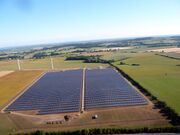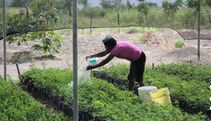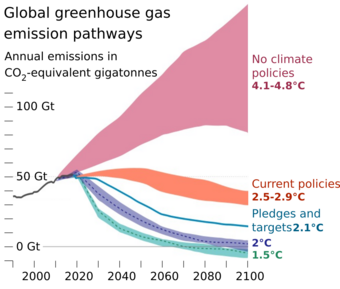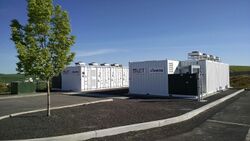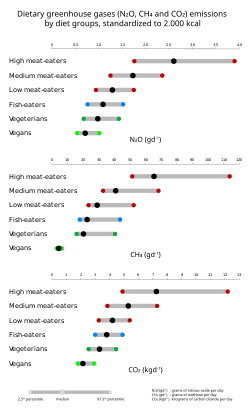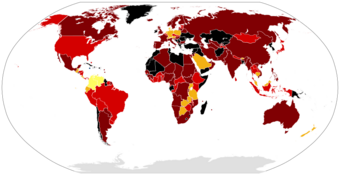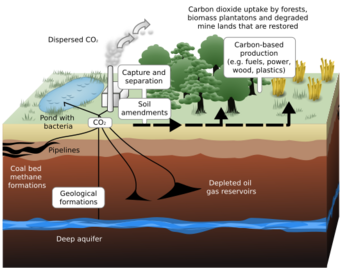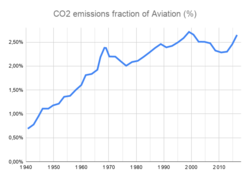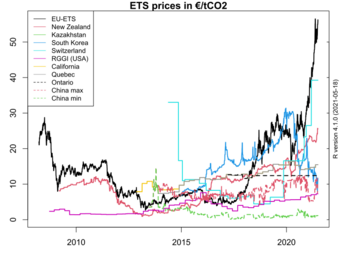Climate change mitigation
Topic: Earth
 From HandWiki - Reading time: 72 min
From HandWiki - Reading time: 72 min
Climate change mitigation (or decarbonisation) is action to limit climate change. This action either reduces emissions of greenhouse gases or removes those gases from the atmosphere.[1][2] The recent rise in global temperature is mostly due to emissions from burning fossil fuels such as coal, oil, and natural gas. There are various ways that mitigation can reduce emissions. These are transitioning to sustainable energy sources, conserving energy, and increasing efficiency. It is possible to remove carbon dioxide (CO
2) from the atmosphere. This can be done by enlarging forests, restoring wetlands and using other natural and technical processes. The name for these processes is carbon sequestration.[3]:12[4] Governments and companies have pledged to reduce emissions to prevent dangerous climate change. These pledges are in line with international negotiations to limit warming.
Solar energy and wind power have the greatest potential for mitigation at the lowest cost compared to a range of other options.[5] The availability of sunshine and wind is variable. But it is possible to deal with this through energy storage and improved electrical grids. These include long-distance electricity transmission, demand management and diversification of renewables.[6]:1 It is possible to reduce emissions from infrastructure that directly burns fossil fuels, such as vehicles and heating appliances, by electrifying the infrastructure. If the electricity comes from renewable sources instead of fossil fuels this will reduce emissions. Using heat pumps and electric vehicles can improve energy efficiency. If industrial processes must create carbon dioxide, carbon capture and storage can reduce net emissions.[7]
Greenhouse gas emissions from agriculture include methane as well as nitrous oxide. It is possible to cut emissions from agriculture by reducing food waste, switching to a more plant-based diet, by protecting ecosystems and by improving farming processes.[8]:XXV Changing energy sources, industrial processes and farming methods can reduce emissions. So can changes in demand for energy, for instance by moving towards low-carbon diets or more sustainable transport in cities. Urban planning and design are among the most effective tools in dealing with climate change, because they address both mitigation and adaptation.[9]
Climate change mitigation policies include: carbon pricing by carbon taxes and carbon emission trading, easing regulations for renewable energy deployment, reductions of fossil fuel subsidies, and divestment from fossil fuels, and subsidies for clean energy.[10] Current policies are estimated to produce global warming of about 2.7 °C by 2100.[11] This warming is significantly above the 2015 Paris Agreement's goal of limiting global warming to well below 2 °C and preferably to 1.5 °C.[12][13] Globally, limiting warming to 2 °C may result in higher economic benefits than economic costs.[14]
Globally, financial flows for climate mitigation and adaptation are estimated to be over $800 billion per year, while requirements are predicted to exceed $4 trillion per year by 2030.[15][16]
Definitions and scope
Climate change mitigation aims to sustain ecosystems to maintain human civilisation. This requires drastic cuts in greenhouse gas emissions .[17](p1–64) The Intergovernmental Panel on Climate Change (IPCC) defines mitigation (of climate change) as "a human intervention to reduce emissions or enhance the sinks of greenhouse gases".[1]:2239
It is possible to approach various mitigation measures in parallel. This is because there is no single pathway to limit global warming to 1.5 or 2 °C.[18]:109 There are four types of measures:
- Sustainable energy and sustainable transport
- Energy conservation, including efficient energy use
- Sustainable agriculture and green industrial policy
- Enhancing carbon sinks and carbon dioxide removal (CDR), including carbon sequestration
The IPCC defined carbon dioxide removal as "Anthropogenic activities removing carbon dioxide (CO
2) from the atmosphere and durably storing it in geological, terrestrial, or ocean reservoirs, or in products. It includes existing and potential anthropogenic enhancement of biological or geochemical CO
2 sinks and direct air carbon dioxide capture and storage (DACCS), but excludes natural CO
2 uptake not directly caused by human activities."[1]
Relationship with solar radiation management (SRM)
Some publications describe solar radiation management (SRM) as a climate mitigation technology.[19][better source needed] Unrelated to greenhouse gas mitigation,[20] SRM would work by changing the way Earth receives solar radiation.[21]:14–56 Examples include reducing the amount of sunlight reaching the surface, reducing the optical thickness and lifetime of clouds, and changing the ability of the surface to reflect radiation.[22] The IPCC describes SRM as a climate risk reduction strategy or supplementary option rather than a climate mitigation option.[21]:14–56
The terminology in this area is still evolving. Experts sometimes use the term geoengineering or climate engineering in the scientific literature for both CDR or SRM, if the techniques are used at a global scale.[17]:6–11 IPCC reports no longer use the terms geoengineering or climate engineering.[1]
Emission trends and pledges
GHG emissions 2020 by gas type
without land-use change
using 100 year GWP
Total: 49.8 GtCO
2e[23]:5
2 mostly by fossil fuel (72%)
Greenhouse gas emissions from human activities strengthen the greenhouse effect. This contributes to climate change. Most is carbon dioxide from burning fossil fuels: coal, oil, and natural gas. Human-caused emissions have increased atmospheric carbon dioxide by about 50% over pre-industrial levels. Emissions in the 2010s averaged a record 56 billion tons (Gt) a year.[25] In 2016, energy for electricity, heat and transport was responsible for 73.2% of GHG emissions. Direct industrial processes accounted for 5.2%, waste for 3.2% and agriculture, forestry and land use for 18.4%.[4]
Electricity generation and transport are major emitters. The largest single source is coal-fired power stations with 20% of greenhouse gas emissions.[26] Deforestation and other changes in land use also emit carbon dioxide and methane. The largest sources of anthropogenic methane emissions are agriculture, and gas venting and fugitive emissions from the fossil-fuel industry. The largest agricultural methane source is livestock. Agricultural soils emit nitrous oxide, partly due to fertilizers.[27] There is now a political solution to the problem of fluorinated gases from refrigerants. This is because many countries have ratified the Kigali Amendment.[28]
Carbon dioxide (CO
2) is the dominant emitted greenhouse gas. Methane (CH
4) emissions almost have the same short-term impact.[29] Nitrous oxide (N2O) and fluorinated gases (F-Gases) play a minor role. Livestock and manure produce 5.8% of all greenhouse gas emissions.[4] But this depends on the time frame used to calculate the global warming potential of the respective gas.[30][31]
Greenhouse gas (GHG) emissions are measured in CO
2 equivalents. Scientists determine their CO
2 equivalents from their global warming potential (GWP). This depends on their lifetime in the atmosphere. There are widely used greenhouse gas accounting methods that convert volumes of methane, nitrous oxide and other greenhouse gases to carbon dioxide equivalents. Estimates largely depend on the ability of oceans and land sinks to absorb these gases. Short-lived climate pollutants (SLCPs) persist in the atmosphere for a period ranging from days to 15 years. Carbon dioxide can remain in the atmosphere for millennia.[32] Short-lived climate pollutants include methane, hydrofluorocarbons (HFCs), tropospheric ozone and black carbon.
Scientists increasingly use satellites to locate and measure greenhouse gas emissions and deforestation. Earlier, scientists largely relied on or calculated estimates of greenhouse gas emissions and governments' self-reported data.[33][34]
Needed emissions cuts
The annual "Emissions Gap Report" by UNEP stated in 2022 that it was necessary to almost halve emissions. "To get on track for limiting global warming to 1.5°C, global annual GHG emissions must be reduced by 45 per cent compared with emissions projections under policies currently in place in just eight years, and they must continue to decline rapidly after 2030, to avoid exhausting the limited remaining atmospheric carbon budget."[8]:xvi The report commented that the world should focus on broad-based economy-wide transformations and not incremental change.[8]:xvi
In 2022, the Intergovernmental Panel on Climate Change (IPCC) released its Sixth Assessment Report on climate change. It warned that greenhouse gas emissions must peak before 2025 at the latest and decline 43% by 2030 to have a good chance of limiting global warming to 1.5 °C (2.7 °F).[35][36] Or in the words of Secretary-General of the United Nations António Guterres: "Main emitters must drastically cut emissions starting this year".[37]
Pledges
Climate Action Tracker described the situation on 9 November 2021 as follows. The global temperature will rise by 2.7 °C by the end of the century with current policies and by 2.9 °C with nationally adopted policies. The temperature will rise by 2.4 °C if countries only implement the pledges for 2030. The rise would be 2.1 °C with the achievement of the long-term targets too. Full achievement of all announced targets would mean the rise in global temperature will peak at 1.9 °C and go down to 1.8 °C by the year 2100.[38] Experts gather information about climate pledges in the Global Climate Action Portal - Nazca. The scientific community is checking their fulfilment.[39]
There has not been a definitive or detailed evaluation of most goals set for 2020. But it appears the world failed to meet most or all international goals set for that year.[40][41]
One update came during the 2021 United Nations Climate Change Conference in Glasgow. The group of researchers running the Climate Action Tracker looked at countries responsible for 85% of greenhouse gas emissions. It found that only four countries or political entities – the EU, UK, Chile and Costa Rica – have published a detailed official policy‑plan that describes the steps to realise 2030 mitigation targets. These four polities are responsible for 6% of global greenhouse gas emissions.[42]
In 2021 the US and EU launched the Global Methane Pledge to cut methane emissions by 30% by 2030. The UK, Argentina, Indonesia, Italy and Mexico joined the initiative. Ghana and Iraq signaled interest in joining. A White House summary of the meeting noted those countries represent six of the top 15 methane emitters globally.[43] Israel also joined the initiative.[44]
Low-carbon energy
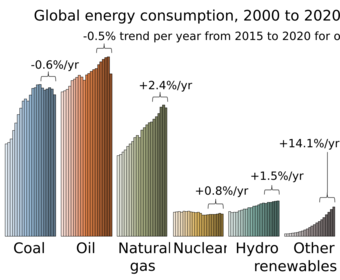
The energy system includes the delivery and use of energy. It is the main emitter of carbon dioxide (CO
2).[46]:6-6 Rapid and deep reductions in the carbon dioxide and other greenhouse gas emissions from the energy sector are necessary to limit global warming to well below 2 °C.[46]:6-3 IPCC recommendations include reducing fossil fuel consumption, increasing production from low- and zero carbon energy sources, and increasing use of electricity and alternative energy carriers.[46]:6-3
Nearly all scenarios and strategies involve a major increase in the use of renewable energy in combination with increased energy efficiency measures.[47]:xxiii It will be necessary to accelerate the deployment of renewable energy six-fold from 0.25% annual growth in 2015 to 1.5% to keep global warming under 2 °C.[48]
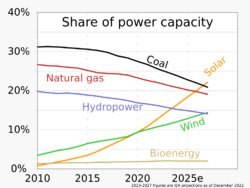
The competitiveness of renewable energy is a key to a rapid deployment. In 2020, onshore wind and solar photovoltaics were the cheapest source for new bulk electricity generation in many regions.[50] Renewables may have higher storage costs but non-renewables may have higher clean-up costs.[51] A carbon price can increase the competitiveness of renewable energy.[52]
Solar and wind energy
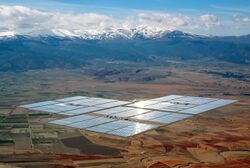
Wind and sun can provide large amounts of low-carbon energy at competitive production costs.[54] The IPCC estimates that these two mitigation options have the largest potential to reduce emissions before 2030 at low cost.[5]:43 Solar photovoltaics (PV) has become the cheapest way to generate electricity in many regions of the world.[55] The growth of photovoltaics has been close to exponential. It has about doubled every three years since the 1990s.[56][57] A different technology is concentrated solar power (CSP). This uses mirrors or lenses to concentrate a large area of sunlight on to a receiver. With CSP, the energy can be stored for a few hours. This provides supply in the evening. Solar water heating doubled between 2010 and 2019.[58]
Regions in the higher northern and southern latitudes have the greatest potential for wind power.[59] Offshore wind farms are more expensive. But offshore units deliver more energy per installed capacity with less fluctuations.[60] In most regions, wind power generation is higher in the winter when PV output is low. For this reason, combinations of wind and solar power lead to better-balanced systems.[61]
Other renewables
Other well-established renewable energy forms include hydropower, bioenergy and geothermal energy.
- Hydroelectricity is electricity generated by hydropower and plays a leading role in countries like Brazil, Norway and China.[62] but there are geographical limits and environmental issues.[63] Tidal power can be used in coastal regions.
- Bioenergy can provide energy for electricity, heat and transport. Bioenergy, in particular biogas, can provide dispatchable electricity generation.[64] While burning plant-derived biomass releases CO
2, the plants withdraw CO
2 from the atmosphere while they grow. The technologies for producing, transporting and processing a fuel have a significant impact on the lifecycle emissions of the fuel.[65] For example, aviation is starting to use renewable biofuels.[66] - Geothermal power is electrical power generated from geothermal energy. Geothermal electricity generation is currently used in 26 countries.[67][68] Geothermal heating is in use in 70 countries.[69]
Integrating variable renewable energy
Wind and solar power production does not consistently match demand.[70][71] To deliver reliable electricity from variable renewable energy sources such as wind and solar, electrical power systems must be flexible.[72] Most electrical grids were constructed for non-intermittent energy sources such as coal-fired power plants.[73] The integration of larger amounts of solar and wind energy into the grid requires a change of the energy system; this is necessary to ensure that the supply of electricity matches demand.[74]
There are various ways to make the electricity system more flexible. In many places, wind and solar generation are complementary on a daily and a seasonal scale. There is more wind during the night and in winter when solar energy production is low.[74] Linking different geographical regions through long-distance transmission lines also makes it possible to reduce variability.[75] It is possible to shift energy demand in time. Energy demand management and the use of smart grids make it possible to match the times when variable energy production is highest.[74] Sector coupling can provide further flexibility. This involves coupling the electricity sector to the heat and mobility sector via power-to-heat-systems and electric vehicles.[76]
Building overcapacity for wind and solar generation can help ensure sufficient electricity production even during poor weather. In optimal weather, it may be necessary to curtail energy generation if it is not possible to use or store excess electricity.[77]
Energy storage helps overcome barriers to intermittent renewable energy.[78] The most commonly used and available storage method is pumped-storage hydroelectricity. This requires locations with large differences in height and access to water.[78] Batteries are also in wide use.[79] They typically store electricity for short periods.[80] Batteries have low energy density. This and their cost makes them impractical for the large energy storage necessary to balance inter-seasonal variations in energy production.[81] Some locations have implemented pumped hydro storage with capacity for multi-month usage.[82]
Nuclear power
Nuclear power could complement renewables for electricity.[83] On the other hand, environmental and security risks could outweigh the benefits.[84][85][86]
The construction of new nuclear reactors currently takes about 10 years. This is much longer than scaling up the deployment of wind and solar.[87]:335 And this timing gives rise to credit risks.[88] However nuclear may be much cheaper in China. China is building a significant number of new power plants.[88] (As of 2019) the cost of extending nuclear power plant lifetimes is competitive with other electricity generation technologies[89] if long term costs for nuclear waste disposal are excluded from the calculation. There is also no sufficient financial insurance for nuclear accidents.[90]
Replacing coal with natural gas
Demand reduction
Reducing demand for products and services that cause greenhouse gas emissions can help in mitigating climate change. One is to reduce demand by behavioural and cultural changes, for example by making changes in diet, especially the decision to reduce meat consumption,[91] an effective action individuals take to fight climate change. Another is by reducing the demand by improving infrastructure, by building a good public transport network, for example. Lastly, changes in end-use technology can reduce energy demand. For instance a well-insulated house emits less than a poorly-insulated house.[92](p119)
Mitigation options that reduce demand for products or services help people make personal choices to reduce their carbon footprint. This could be in their choice of transport or food.[93]:5-3 So these mitigation options have many social aspects that focus on demand reduction; they are therefore demand-side mitigation actions. For example, people with high socio-economic status often cause more greenhouse gas emissions than those from a lower status. If they reduce their emissions and promote green policies, these people could become low-carbon lifestyle role models.[93]:5-4 However, there are many psychological variables that influence consumers. These include awareness and perceived risk. Government policies can support or hinder demand-side mitigation options. For example, public policy can promote circular economy concepts which would support climate change mitigation.[93]:5–6 Reducing greenhouse gas emissions is linked to the sharing economy.
There is a debate regarding the correlation of economic growth and emissions. It seems economic growth no longer necessarily means higher emissions.[94][95]
Energy conservation and efficiency
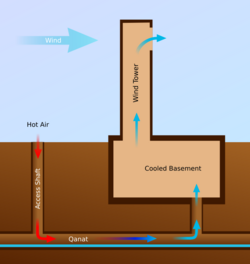
Global primary energy demand exceeded 161,000 terawatt hours (TWh) in 2018.[98] This refers to electricity, transport and heating including all losses. In transport and electricity production, fossil fuel usage has a low efficiency of less than 50%. Large amounts of heat in power plants and in motors of vehicles go to waste. The actual amount of energy consumed is significantly lower at 116,000 TWh.[99]
Energy conservation is the effort made to reduce the consumption of energy by using less of an energy service. One way is to use energy more efficiently. This means using less energy than before to produce the same service. Another way is to reduce the amount of service used. An example of this would be to drive less. Energy conservation is at the top of the sustainable energy hierarchy.[100] When consumers reduce wastage and losses they can conserve energy. The upgrading of technology as well as the improvements to operations and maintenance can result in overall efficiency improvements.
Efficient energy use (or energy efficiency) is the process of reducing the amount of energy required to provide products and services. Improved energy efficiency in buildings ("green buildings"), industrial processes and transportation could reduce the world's energy needs in 2050 by one third. This would help reduce global emissions of greenhouse gases.[101] For example, insulating a building allows it to use less heating and cooling energy to achieve and maintain thermal comfort. Improvements in energy efficiency are generally achieved by adopting a more efficient technology or production process.[102] Another way is to use commonly accepted methods to reduce energy losses.
Lifestyle changes
Individual action on climate change can include personal choices in many areas. These include diet, travel, household energy use, consumption of goods and services, and family size. People who wish to reduce their carbon footprint can take high-impact actions such as avoiding frequent flying and petrol-fuelled cars, eating mainly a plant-based diet, having fewer children,[105][106] using clothes and electrical products for longer,[107] and electrifying homes.[108][109] These approaches are more practical for people in high-income countries with high-consumption lifestyles. Naturally, it is more difficult for those with lower income statuses to make these changes. This is because choices like electric-powered cars may not be available. Excessive consumption is more to blame for climate change than population increase.[110] High-consumption lifestyles have a greater environmental impact, with the richest 10% of people emitting about half the total lifestyle emissions.[111][112]
Dietary change
Some scientists say that avoiding meat and dairy foods is the single biggest way an individual can reduce their environmental impact.[113] The widespread adoption of a vegetarian diet could cut food-related greenhouse gas emissions by 63% by 2050.[114] China introduced new dietary guidelines in 2016 which aim to cut meat consumption by 50% and thereby reduce greenhouse gas emissions by 1 Gt per year by 2030.[115] Overall, food accounts for the largest share of consumption-based greenhouse gas emissions. It is responsible for nearly 20% of the global carbon footprint. Almost 15% of all anthropogenic greenhouse gas emissions have been attributed to the livestock sector.[109]
A shift towards plant-based diets would help to mitigate climate change.[116] In particular, reducing meat consumption would help to reduce methane emissions.[117] If high-income nations switched to a plant-based diet, vast amounts of land used for animal agriculture could be allowed to return to their natural state. This in turn has the potential to sequester 100 billion tonnes of CO
2 by the end of the century.[118][119] A comprehensive analysis found that plant based diets reduce emissions, water pollution and land use significantly (by 75%), while reducing the destruction of wildlife and usage of water.[120]
Family size
Preserving and enhancing carbon sinks
An important mitigation measure is "preserving and enhancing carbon sinks".[5] This refers to the management of Earth's natural carbon sinks in a way that preserves or increases their capability to remove CO2 from the atmosphere and to store it durably. Scientists call this process also carbon sequestration. In the context of climate change mitigation, the IPCC defines a sink as "Any process, activity or mechanism which removes a greenhouse gas, an aerosol or a precursor of a greenhouse gas from the atmosphere".[1]:2249 Globally, the two most important carbon sinks are vegetation and the ocean.[121]
To enhance the ability of ecosystems to sequester carbon, changes are necessary in agriculture and forestry.[122] Examples are preventing deforestation and restoring natural ecosystems by reforestation.[123]:266 Scenarios that limit global warming to 1.5 °C typically project the large-scale use of carbon dioxide removal methods over the 21st century.[124]:1068[125]:17 There are concerns about over-reliance on these technologies, and their environmental impacts.[125]:17[126]:34 But ecosystem restoration and reduced conversion are among the mitigation tools that can yield the most emissions reductions before 2030.[5]:43
Land-based mitigation options are referred to as "AFOLU mitigation options" in the 2022 IPCC report on mitigation. The abbreviation stands for "agriculture, forestry and other land use"[5]:37 The report described the economic mitigation potential from relevant activities around forests and ecosystems as follows: "the conservation, improved management, and restoration of forests and other ecosystems (coastal wetlands, peatlands, savannas and grasslands)". A high mitigation potential is found for reducing deforestation in tropical regions. The economic potential of these activities has been estimated to be 4.2 to 7.4 gigatonnes of carbon dioxide equivalent (GtCO2 -eq) per year.[5]:37
Forests
Conservation
The Stern Review on the economics of climate change stated in 2007 that curbing deforestation was a highly cost-effective way of reducing greenhouse gas emissions.[127] About 95% of deforestation occurs in the tropics, where clearing of land for agriculture is one of the main causes.[128] One forest conservation strategy is to transfer rights over land from public ownership to its indigenous inhabitants.[129] Land concessions often go to powerful extractive companies.[129] Conservation strategies that exclude and even evict humans, called fortress conservation, often lead to more exploitation of the land. This is because the native inhabitants turn to work for extractive companies to survive.[130]
Proforestation is promoting forests to capture their full ecological potential.[131] This is a mitigation strategy as secondary forests that have regrown in abandoned farmland are found to have less biodiversity than the original old-growth forests. Original forests store 60% more carbon than these new forests.[132] Strategies include rewilding and establishing wildlife corridors.[133][134]
Mitigation measures in forestry are slow. They often have trade-offs with food prices. And they can lead to spill-over effects on climate from indirect land use change.[citation needed] Additionally, the long-term success of forestry mitigation measures depends on careful consideration of their ecological impact and their integration into broader sustainable land use practices.[citation needed]
Afforestation and reforestation
Afforestation is the establishment of trees where there was previously no tree cover. Scenarios for new plantations covering up to 4000 million hectares (Mha) (6300 x 6300 km) suggest cumulative carbon storage of more than 900 GtC (2300 GtCO
2) until 2100.[135] But they are not a viable alternative to aggressive emissions reduction.[136] This is because the plantations would need to be so large they would eliminate most natural ecosystems or reduce food production.[137] One example is the Trillion Tree Campaign.[138][139]
Reforestation is the restocking of existing depleted forests or in places where there were recently forests. Reforestation could save at least 1 GtCO2 per year, at an estimated cost of $5–15 per tonne of carbon dioxide (tCO2).[142] Restoring all degraded forests all over the world could capture about 205 GtC (750 GtCO
2).[143] With increased intensive agriculture and urbanization, there is an increase in the amount of abandoned farmland. By some estimates, for every acre of original old-growth forest cut down, more than 50 acres of new secondary forests are growing.[132][144] In some countries, promoting regrowth on abandoned farmland could offset years of emissions.[145]
Planting new trees can be expensive and a risky investment. For example, about 80 percent of planted trees in the Sahel die within two years.[140] Reforestation has higher carbon storage potential than afforestation. In mangroves reforestation is predicted to provide 60% more carbon uptake per hectare in the 40 years after planting. Estuarine and coastal wetland ecosystems could see a 4.3-5.1% increase in annual CO2 uptake by reforesting available mangrove areas.[146] Even long-deforested areas still contain an "underground forest" of living roots and tree stumps. Helping native species sprout naturally is cheaper than planting new trees and they are more likely to survive. This could include pruning and coppicing to accelerate growth. This also provides woodfuel, which is otherwise a major source of deforestation. Such practices, called farmer-managed natural regeneration, are centuries old but the biggest obstacle towards implementation is ownership of the trees by the state. The state often sells timber rights to businesses which leads to locals uprooting seedlings because they see them as a liability. Legal aid for locals[147][148] and changes to property law such as in Mali and Niger have led to significant changes. Scientists describe them as the largest positive environmental transformation in Africa. It is possible to discern from space the border between Niger and the more barren land in Nigeria, where the law has not changed.[140][141]
Soils
There are many measures to increase soil carbon.[149] This makes it complex[150] and hard to measure and account for.[151] One advantage is that there are fewer trade-offs for these measures than for BECCS or afforestation, for example.[citation needed]
Globally, protecting healthy soils and restoring the soil carbon sponge could remove 7.6 billion tonnes of carbon dioxide from the atmosphere annually. This is more than the annual emissions of the US.[152][153] Trees capture CO
2 while growing above ground and exuding larger amounts of carbon below ground. Trees contribute to the building of a soil carbon sponge. Carbon formed above ground is released as CO
2 immediately when wood is burned. If dead wood remains untouched, only some of the carbon returns to the atmosphere as decomposition proceeds.[152]
Methods that enhance carbon sequestration in soil include no-till farming, residue mulching and crop rotation. Organic farming makes more use of these techniques than conventional farming does.[154][155] Because only 5% of US farmland currently uses no-till and residue mulching, there is a large potential for carbon sequestration.[156][157]
Farming can deplete soil carbon and render soil incapable of supporting life. However, conservation farming can protect carbon in soils, and repair damage over time.[158] The farming practice of cover crops is a form of climate-smart agriculture.[159] Scientists have described the best management practices for European soils to increase soil organic carbon. These are conversion of arable land to grassland, straw incorporation, reduced tillage, straw incorporation combined with reduced tillage, ley cropping system and cover crops.[160]
Regenerative agriculture includes conservation tillage, diversity, rotation and cover crops. It also includes minimizing physical disturbance and supporting carbon sequestration in soils.[161][162] It has other benefits like improving the state of the soil and consequently yields.[163]
Another mitigation option is the production of biochar and its storage in soils This is the solid material that remains after the pyrolysis of biomass. Biochar production releases half of the carbon from the biomass—either released into the atmosphere or captured with CCS—and retains the other half in the stable biochar.[164] It can endure in soil for thousands of years.[165] Biochar may increase the soil fertility of acidic soils and increase agricultural productivity. During production of biochar, heat is released which may be used as bioenergy.[164]
Wetlands
Wetland restoration is an important mitigation measure. It has moderate to great mitigation potential on a limited land area with low trade-offs and costs.[citation needed] Wetlands perform two important functions in relation to climate change. They can sequester carbon, converting carbon dioxide to solid plant material through photosynthesis. They also store and regulate water.[166][167] Wetlands store about 45 million tonnes of carbon per year globally.[168]
Some wetlands are a significant source of methane emissions.[169] Some also emit nitrous oxide.[170][171] Peatland globally covers just 3% of the land's surface.[172] But it stores up to 550 gigatonnes (Gt) of carbon. This represents 42% of all soil carbon and exceeds the carbon stored in all other vegetation types, including the world's forests.[173] The threat to peatlands includes draining the areas for agriculture. Another threat is cutting down trees for lumber, as the trees help hold and fix the peatland.[174][175] Additionally, peat is often sold for compost.[176] It is possible to restore degraded peatlands by blocking drainage channels in the peatland, and allowing natural vegetation to recover.[133][177]
Mangroves, salt marshes and seagrasses make up the majority of the ocean's vegetated habitats. They only equal 0.05% of the plant biomass on land. But they store carbon 40 times faster than tropical forests.[133] Bottom trawling, dredging for coastal development and fertilizer runoff have damaged coastal habitats. Notably, 85% of oyster reefs globally have been removed in the last two centuries. Oyster reefs clean the water and help other species thrive. This increases biomass in that area. In addition, oyster reefs mitigate the effects of climate change by reducing the force of waves from hurricanes. They also reduce the erosion from rising sea levels.[178] Restoration of coastal wetlands is thought to be more cost-effective than restoration of inland wetlands.[179]
Deep ocean
These options focus on the carbon which ocean reservoirs can store. They include ocean fertilization, ocean alkalinity enhancement or enhanced weathering.[180]:12–36 The IPCC found in 2022 ocean-based mitigation options currently have only limited deployment potential. But it assessed that their future mitigation potential is large.[180]:12–4 It found that in total, ocean-based methods could remove 1–100 Gt of CO
2 per year.[92]:TS-94 Their costs are in the order of 40–500 USD per tonne of CO
2. Most of these options could also help to reduce ocean acidification. This is the drop in pH value caused by increased atmospheric CO2 concentrations.[181]
Blue carbon management is another type of ocean-based biological carbon dioxide removal (CDR). It can involve land-based as well as ocean-based measures.[180]:12–51 [182]:764 The term usually refers to the role that tidal marshes, mangroves and seagrasses can play in carbon sequestration.[1]:2220 Some of these efforts can also take place in deep ocean waters. This is where the vast majority of ocean carbon is held. These ecosystems can contribute to climate change mitigation and also to ecosystem-based adaptation. Conversely, when blue carbon ecosystems are degraded or lost they release carbon back to the atmosphere.[1]:2220 There is increasing interest in developing blue carbon potential.[183] Scientists have found that in some cases these types of ecosystems remove far more carbon per area than terrestrial forests. However, the long-term effectiveness of blue carbon as a carbon dioxide removal solution remains under discussion.[184][183][185]
Enhanced weathering
Enhanced weathering could remove 2–4 Gt of CO
2 per year. This process aims to accelerate natural weathering by spreading finely ground silicate rock, such as basalt, onto surfaces. This speeds up chemical reactions between rocks, water, and air. It removes carbon dioxide from the atmosphere, permanently storing it in solid carbonate minerals or ocean alkalinity.[186] Cost estimates are in the 50-200 USD per tonne range of CO
2.[92]:TS-94
Other methods to capture and store CO2
In addition to traditional land-based methods to remove carbon dioxide (CO2) from the air, other technologies are under development. These could reduce CO2 emissions and lower existing atmospheric CO2 levels. Carbon capture and storage (CCS) is a method to mitigate climate change by capturing CO2 from large point sources, such as cement factories or biomass power plants. It then stores it away safely instead of releasing it into the atmosphere. The IPCC estimates that the costs of halting global warming would double without CCS.[187]
Bioenergy with carbon capture and storage (BECCS) expands on the potential of CCS and aims to lower atmospheric CO2 levels. This process uses biomass grown for bioenergy. The biomass yields energy in useful forms such as electricity, heat, biofuels, etc. through consumption of the biomass via combustion, fermentation, or pyrolysis. The process captures the CO2 that was extracted from the atmosphere when it grew. It then stores it underground or via land application as biochar. This effectively removes it from the atmosphere.[188] This makes BECCS a negative emissions technology (NET).[189]
Scientists estimated the potential range of negative emissions from BECCS in 2018 as 0-22 Gt per year.[190] (As of 2022), BECCS was capturing approximately 2 million tonnes per year of CO2 annually.[191] The cost and availability of biomass limits wide deployment of BECCS.[192][193]:10 BECCS currently forms a big part of achieving climate targets beyond 2050 in modelling, such as by the Integrated Assessment Models (IAMs) associated with the IPCC process. But many scientists are sceptical due to the risk of loss of biodiversity.[194]
Direct air capture is a process of capturing CO
2 directly from the ambient air. This is in contrast to CCS which captures carbon from point sources. It generates a concentrated stream of CO
2 for sequestration, utilization or production of carbon-neutral fuel and windgas.[195] Artificial processes vary, and there are concerns about the long-term effects of some of these processes.[196][obsolete source]
Mitigation by sector
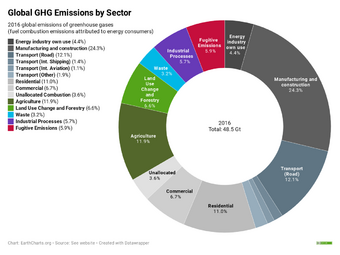
2 equivalent quantities (GtCO
2e).
Buildings
The building sector accounts for 23% of global energy-related CO
2 emissions.[18]:141 About half of the energy is used for space and water heating.[198] Building insulation can reduce the primary energy demand significantly. Heat pump loads may also provide a flexible resource that can participate in demand response to integrate variable renewable resources into the grid.[199] Solar water heating uses thermal energy directly. Sufficiency measures include moving to smaller houses when the needs of households change, mixed use of spaces and the collective use of devices.[92]:71 Planners and civil engineers can construct new buildings using passive solar building design, low-energy building, or zero-energy building techniques. In addition, it is possible to design buildings that are more energy-efficient to cool by using lighter-coloured, more reflective materials in the development of urban areas.

Heat pumps efficiently heat buildings, and cool them by air conditioning. A modern heat pump typically transports around three to five times more thermal energy than electrical energy consumed. The amount depends on the coefficient of performance and the outside temperature.[200]
Refrigeration and air conditioning account for about 10% of global CO
2 emissions caused by fossil fuel-based energy production and the use of fluorinated gases. Alternative cooling systems, such as passive cooling building design and passive daytime radiative cooling surfaces, can reduce air conditioning use. Suburbs and cities in hot and arid climates can significantly reduce energy consumption from cooling with daytime radiative cooling.[201]
Energy consumption for cooling is likely to rise significantly due to increasing heat and availability of devices in poorer countries. Of the 2.8 billion people living in the hottest parts of the world, only 8% currently have air conditioners, compared with 90% of people in the US and Japan.[202] By combining energy efficiency improvements with the transition away from super-polluting refrigerants, the world could avoid cumulative greenhouse gas emissions of up to 210–460 GtCO
2-eq over the next four decades.[203] A shift to renewable energy in the cooling sector comes with two advantages. Solar energy production with mid-day peaks corresponds with the load required for cooling. Additionally, cooling has a large potential for load management in the electric grid.
Transport
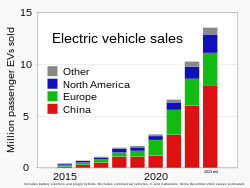
Transportation accounts for 15% of emissions worldwide.[205] Increasing the use of public transport, low-carbon freight transport and cycling are important components of transport decarbonisation.[206][207]
Electric vehicles and environmentally friendly rail help to reduce the consumption of fossil fuels. In most cases, electric trains are more efficient than air transport and truck transport.[208] Other efficiency means include improved public transport, smart mobility, carsharing and electric hybrids. Fossil-fuel for passenger cars can be included in emissions trading.[209] Furthermore, moving away from a car-dominated transport system towards low-carbon advanced public transport system is important.[210]
Heavyweight, large personal vehicles (such as cars) require a lot of energy to move and take up much urban space.[211][212] Several alternatives modes of transport are available to replace these. The European Union has made smart mobility part of its European Green Deal.[213] In smart cities, smart mobility is also important.[214]
The World Bank is helping lower income countries buy electric buses. Their purchase price is higher than diesel buses. But lower running costs and health improvements due to cleaner air can offset this higher price.[215]
Between one quarter and three quarters of cars on the road by 2050 are forecast to be electric vehicles.[216] Hydrogen may be a solution for long-distance heavy freight trucks, if batteries alone are too heavy.[217]
Shipping
In the shipping industry, the use of liquefied natural gas (LNG) as a marine bunker fuel is driven by emissions regulations. Ship operators must switch from heavy fuel oil to more expensive oil-based fuels, implement costly flue gas treatment technologies or switch to LNG engines.[218] Methane slip, when gas leaks unburned through the engine, lowers the advantages of LNG. Maersk, the world's biggest container shipping line and vessel operator, warns of stranded assets when investing in transitional fuels like LNG.[219] The company lists green ammonia as one of the preferred fuel types of the future. It has announced the first carbon-neutral vessel on the water by 2023, running on carbon-neutral methanol.[220] Cruise operators are trialling partially hydrogen-powered ships.[221]
Hybrid and all electric ferries are suitable for short distances. Norway's goal is an all electric fleet by 2025.[222]
Air transport
Jet airliners contribute to climate change by emitting carbon dioxide, nitrogen oxides, contrails and particulates. Their radiative forcing is estimated at 1.3–1.4 that of CO
2 alone, excluding induced cirrus cloud. In 2018, global commercial operations generated 2.4% of all CO
2 emissions.[224]
The aviation industry has become more fuel efficient. But overall emissions have risen as the volume of air travel has increased. By 2020, aviation emissions were 70% higher than in 2005 and they could grow by 300% by 2050.[225]
It is possible to reduce aviation's environmental footprint by better fuel economy in aircraft. Optimising flight routes to lower non-CO
2 effects on climate from nitrogen oxides, particulates or contrails can also help. Aviation biofuel, carbon emission trading and carbon offsetting, part of the 191 nation ICAO's Carbon Offsetting and Reduction Scheme for International Aviation (CORSIA), can lower CO
2 emissions. Short-haul flight bans, train connections, personal choices and taxation on flights can lead to fewer flights. Hybrid electric aircraft and electric aircraft or hydrogen-powered aircraft may replace fossil fuel-powered aircraft.
Experts expect emissions from aviation to rise in most projections, at least until 2040. They currently amount to 180 Mt of CO
2 or 11% of transport emissions. Aviation biofuel and hydrogen can only cover a small proportion of flights in the coming years. Experts expect hybrid-driven aircraft to start commercial regional scheduled flights after 2030. Battery-powered aircraft are likely to enter the market after 2035.[226] Under CORSIA, flight operators can purchase carbon offsets to cover their emissions above 2019 levels. CORSIA will be compulsory from 2027.
Agriculture, forestry and land use

Almost 20% of greenhouse gas emissions come from the agriculture and forestry sector.[227] Mitigation measures in the food system can be divided into four categories. These are demand-side changes, ecosystem protections, mitigation on farms, and mitigation in supply chains. On the demand side, limiting food waste is an effective way to reduce food emissions. Changes to a diet less reliant on animal products such as plant-based diets are also effective.[8]:XXV
With 21% of global methane emissions, cattle are a major driver of global warming.[3]:6 When rainforests are cut and the land is converted for grazing, the impact is even higher. In Brazil, producing 1 kg of beef can result in the emission of up to 335 kg CO2-eq.[228] Other livestock, manure management and rice cultivation also emit greenhouse gases, in addition to fossil fuel combustion in agriculture.
Important mitigation options for reducing the greenhouse gas emissions from livestock include genetic selection,[229][230] introduction of methanotrophic bacteria into the rumen,[231][232] vaccines, feeds,[233] diet modification and grazing management.[234][235][236] Other options are diet changes towards ruminant-free alternatives, such as milk substitutes and meat analogues. Non-ruminant livestock, such as poultry, emit far fewer GHGs.[237]
It is possible to cut methane emissions in rice cultivation by improved water management, combining dry seeding and one drawdown, or executing a sequence of wetting and drying. This results in emission reductions of up to 90% compared to full flooding and even increased yields.[238]
Industry
Industry is the largest emitter of greenhouse gases when direct and indirect emissions are included. Electrification can reduce emissions from industry. Green hydrogen can play a major role in energy-intensive industries for which electricity is not an option. Further mitigation options involve the steel and cement industry, which can switch to a less polluting production process. Products can be made with less material to reduce emission-intensity and industrial processes can be made more efficient. Finally, circular economy measures reduce the need for new materials. This also saves on emissions that would have been released from the mining of collecting of those materials.[8]:43
The decarbonisation of cement production requires new technologies, and therefore investment in innovation.[239] Bioconcrete is one possibility to reduce emissions.[240] But no technology for mitigation is yet mature. So CCS will be necessary at least in the short-term.[241] Blast furnaces could be replaced by hydrogen direct reduced iron and electric arc furnaces.[242]
Coal, gas and oil production often come with significant methane leakage.[243] In the early 2020s some governments recognized the scale of the problem and introduced regulations.[244] Methane leaks at oil and gas wells and processing plants are cost-effective to fix in countries which can easily trade gas internationally.[243] There are leaks in countries where gas is cheap; such as Iran,[245] Russia,[246] and Turkmenistan.[247] Nearly all this can be stopped by replacing old components and preventing routine flaring.[243] Coalbed methane may continue leaking even after the mine has been closed. But it can be captured by drainage and/or ventilation systems.[248] Fossil fuel firms do not always have financial incentives to tackle methane leakage.[249]
Co-benefits
Health and well-being
The health benefits from climate change mitigation are significant. Potential measures can not only mitigate future health impacts from climate change but also improve health directly.[250][251] Climate change mitigation is interconnected with various health co-benefits, such as those from reduced air pollution.[251] Air pollution generated by fossil fuel combustion is both a major driver of global warming and the cause of a large number of annual deaths. Some estimates are as high as 8.7 million excess deaths during 2018.[252][253] Mitigation policies can also promote healthier diets such as less red meat, more active lifestyles, and increased exposure to green urban spaces.[254]:26 Access to urban green spaces provides benefits to mental health as well.[254]:18 The increased use of green and blue infrastructure can reduce the urban heat island effect. This reduces heat stress on people.[92]:TS-66 Studies suggest that efforts to reduce consumption of goods and services have largely beneficial effects on 18 constituents of well-being.[255][256]
Future sustainable pathways scenarios may result in an annual reduction of 1.18 million air pollution-related deaths, 5.86 million diet-related deaths, and 1.15 million deaths due to physical inactivity, across nine countries by 2040. These benefits were attributable to the mitigation of direct greenhouse gas emissions and the accompanying actions that reduce exposure to harmful pollutants, as well as improved diets and safe physical activity.[257] Globally the cost of limiting warming to 2 °C is less than the value of the extra years of life due to cleaner air - and in India and China much less.[257]
In the transportation sector mitigation strategies could enable more equitable access to transportation services and reduce congestion.[5]:SPM-32
Addressing inequality can assist with climate change mitigation efforts.[5]:38 Placing health as a key focus of the Nationally Determined Contributions could present an opportunity to increase ambition and realise health co-benefits.[257]
Climate change adaptation
Some mitigation measures have co-benefits in the area of climate change adaptation.[258]:8–63 This is for example the case for many nature-based solutions.[259]:4–94[260]:6 Examples in the urban context include urban green and blue infrastructure which provide mitigation as well as adaptation benefits. This can be in the form of urban forests and street trees, green roofs and walls, urban agriculture and so forth. The mitigation is achieved through the conservation and expansion of carbon sinks and reduced energy use of buildings. Adaptation benefits come for example through reduced heat stress and flooding risk.[258]:8–64
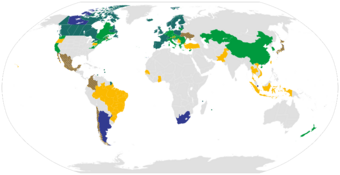
Costs and funding
Several factors affect mitigation cost estimates. One is the baseline. This is a reference scenario that the alternative mitigation scenario is compared with. Others are the way costs are modelled, and assumptions about future government policy.[262]:622 Cost estimates for mitigation for specific regions depend on the quantity of emissions allowed for that region in future, as well as the timing of interventions.[263]:90
Mitigation costs will vary according to how and when emissions are cut. Early, well-planned action will minimize the costs.[142] Globally, the benefits of keeping warming under 2 °C exceed the costs.[257]
Economists estimate the cost of climate change mitigation at between 1% and 2% of GDP.[264] Whereas this is a large sum, it is still far less than the subsidies governments provide to the ailing fossil fuel industry. The International Monetary Fund estimated this at more than $5 trillion per year.[265][47]
The economic repercussions of mitigation vary widely across regions and households, depending on policy design and level of international cooperation. Delayed global cooperation increases policy costs across regions, especially in those that are relatively carbon intensive at present. Pathways with uniform carbon values show higher mitigation costs in more carbon-intensive regions, in fossil-fuels exporting regions and in poorer regions. Aggregate quantifications expressed in GDP or monetary terms undervalue the economic effects on households in poorer countries. The actual effects on welfare and well-being are comparatively larger.[266]
Cost–benefit analysis may be unsuitable for analysing climate change mitigation as a whole. But it is still useful for analysing the difference between a 1.5 °C target and 2 °C.[264] One way of estimating the cost of reducing emissions is by considering the likely costs of potential technological and output changes. Policymakers can compare the marginal abatement costs of different methods to assess the cost and amount of possible abatement over time. The marginal abatement costs of the various measures will differ by country, by sector, and over time.[142]
Avoided costs of climate change effects
It is possible to avoid some of the costs of the effects of climate change by limiting climate change. According to the Stern Review, inaction can be as high as the equivalent of losing at least 5% of global gross domestic product (GDP) each year, now and forever. This can be up to 20% of GDP or more when including a wider range of risks and impacts. But mitigating climate change will only cost about 2% of GDP. Also it may not be a good idea from a financial perspective to delay significant reductions in greenhouse gas emissions.[267][268]
Mitigation solutions are often evaluated in terms of costs and greenhouse gas reduction potentials. This fails to take into account the direct effects on human well-being.[269]
Distributing emissions abatement costs
Mitigation at the speed and scale required to limit warming to 2 °C or below implies deep economic and structural changes. These raise multiple types of distributional concerns across regions, income classes and sectors.[266]
There have been different proposals on how to allocate responsibility for cutting emissions.[270]:103 These include egalitarianism, basic needs according to a minimum level of consumption, proportionality and the polluter-pays principle. A specific proposal is "equal per capita entitlements".[270]:106 This approach has two categories. In the first category, emissions are allocated according to national population. In the second category, emissions are allocated in a way that attempts to account for historical or cumulative emissions.
Funding
In order to reconcile economic development with mitigating carbon emissions, developing countries need particular support. This would be both financial and technical. The IPCC found that accelerated support would also tackle inequities in financial and economic vulnerability to climate change.[271] One way to achieve this is the Kyoto Protocol's Clean Development Mechanism (CDM).
Feasibility and potential of and risk in mitigation
To achieve a drastic reduction in emissions and a significant increase in carbon uptake from the atmosphere, the Intergovernmental Panel on Climate Change (IPCC), in 2022, recommended a considerable number of mitigation options whose feasibility and potential are yet to be examined in each context. The IPCC endorsed an approach to assess the ʽfeasibilityʼ of mitigation options. The approach suggests that the assessment of options can be done by taking into consideration six feasibility dimensions, namely geophysical, environmental-ecological, technological, economic, socio-cultural, and institutional dimensions. The approach has been developed with a special focus on identifying barriers to and enablers of the deployment of mitigation actions and thus assessing their feasibility (IPCC, 2022). For the IPCC a mitigation option can fail to achieve its intended outcome, or create an adverse outcome elsewhere. This means uncertainty about mitigation outcomes or risk. Despite these developments, in specifying mitigation actions, it has been suggested further describing uncertainty and exhausting knowledge about the context of the option. The systematic evaluation of assumptions is also recommended [272]
Policies
Municipal policies and urban planning
Cities have a big potential to reduce greenhouse gas emissions. They emitted 28 GtCO2-eq in 2020 of combined CO2 and CH
4 emissions.[92]:TS-61 This was from producing and consuming goods and services.[92]:TS-61 Climate-smart urban planning aims to reduce sprawl to reduce the distance travelled. This lowers emissions from transportation. It supports mixed use of space and transit. Walking, cycling and sharing vehicles can reduce urban emissions. Urban forestry, lakes and other blue and green infrastructure can reduce emissions directly and indirectly by reducing energy demand for cooling.[92]:TS-66 Personal cars are extremely inefficient at moving passengers. Public transport and bicycles are many times more efficient in an urban context. Switching from cars by improving walkability and cycling infrastructure is either free or beneficial to a country's economy as a whole.[274] Methane emissions from municipal solid waste can be reduced by segregation, composting, and recycling.[275]
National policies
Climate change mitigation policies can have a large and complex impact on the socio-economic status of individuals and countries This can be both positive and negative.[276] It is important to design policies well and make them inclusive. Otherwise climate change mitigation measures can impose higher financial costs on poor households.[277]
The most effective and economically efficient approach of achieving lower emissions in the energy sector is to apply a combination of measures. These include market-based instruments such as taxes and permits, standards, and information policies.[278]:422
Types of national policies that would support climate change mitigation include:
- Regulatory standards: These set technology or performance standards. They can be effective in addressing the market failure of informational barriers.[278]:412 If the costs of regulation are less than the benefits of addressing the market failure, standards can result in net benefits. One example is fuel-efficiency standards for cars.[279]
- Market-based instruments such as emission taxes and charges. An emissions tax requires domestic emitters to pay a fixed fee or tax for every tonne of CO2-eq GHG emissions they release into the atmosphere.[278]:4123 If every emitter were to face the same level of tax, emitters would choose the lowest cost way of achieving emission reductions first. In the real world, however, markets are not perfect. This means that an emissions tax may deviate from this ideal. Distributional and equity considerations usually result in differential tax rates for different sources.
- Tradable permits: A permit system can limit emissions.[278]:415 A number of permits are distributed equal to the emission limit. Each liable entity must hold the number of permits equal to its actual emissions. A tradable permit system can be cost-effective if costs are not excessive. There must also be no significant imperfections in the permit market and markets relating to emitting activities.
- Voluntary agreements: These are agreements between governments, often in the form of public agencies, and industry.[278]:417 Agreements may relate to general issues, such as research and development. In other cases they may involve quantitative targets. There is, however, the risk that participants in the agreement will free ride. They can do this by not complying with the agreement or by benefitting from the agreement while bearing no cost.
- Informational instruments: Poor information is a barrier to improving energy efficiency or reducing emissions.[278]:419 Examples of policies in this area include increasing public awareness of energy saving with home heating and insulation[280] or emissions from meat and dairy products.[281][282] However some say that it is politically toxic for a politician to ask people to eat less meat.[283]
- Research and development policies: Some areas, such as soil, may differ by country and so need national research.[284] Technologies may need financial support to reach commercial scale, for example floating wind power.[285]
- Low carbon power: Governments may relax planning regulations on solar power and onshore wind.[286] They may also partly finance technologies considered risky by the private sector, such as nuclear.[287]
- Demand-side management: This aims to reduce energy demand, e.g. through energy audits, labelling, and regulation.[278]:422
- Adding or removing subsidies:
- A subsidy for greenhouse gas emissions reductions pays entities a specific amount per tonne of CO2-eq for every tonne of greenhouse gas reduced or sequestered.[278]:421 Subsidies are generally less efficient than taxes. But distributional and competitiveness issues sometimes result when energy/emission taxes are coupled with subsidies or tax exceptions.
- Creating subsidies and financial incentives.[288] One example is energy subsidies to support clean generation which is not yet commercially viable such as tidal power.[289]
- Phasing-out of unhelpful subsidies. Many countries provide subsidies for activities that affect emissions. Examples are subsidies in the agriculture and energy sectors, and indirect subsidies for transport.
- A Green Marshall Plan. This calls for global central bank money creation to fund green infrastructure.[290][291][292]
- Market liberalization: Energy markets have been restructured in several countries and regions. These policies mainly aim to increase competition in the market. But they can also have a significant impact on emissions.[293]:409–410
Phasing out fossil fuel subsidies
Carbon pricing
Imposing additional costs on greenhouse gas emissions can make fossil fuels less competitive and accelerate investments into low-carbon sources of energy. A growing number of countries raise a fixed carbon tax or participate in dynamic carbon emission trading (ETS) systems. In 2021, more than 21% of global greenhouse gas emissions were covered by a carbon price. This was a big increase from earlier due to the introduction of the Chinese national carbon trading scheme.[294]:23
Trading schemes offer the possibility to limit emission allowances to certain reduction targets. However, an oversupply of allowances keeps most ETS at low price levels around $10 with a low impact. This includes the Chinese ETS which started with $7/tCO
2 in 2021.[295] One exception is the European Union Emission Trading Scheme where prices began to rise in 2018. They reached about €80/tCO
2 in 2022.[296] This results in additional costs of about €0.04/KWh for coal and €0.02/KWh for gas combustion for electricity, depending on the emission intensity.[citation needed]
Industries which have high energy requirements and high emissions often pay only very low energy taxes, or even none at all.[297]:11–80
Methane emissions from fossil fuel extraction are occasionally taxed.[298] But methane and nitrous oxide from agriculture are typically not subject to tax.[299]
International agreements
Almost all countries are parties to the United Nations Framework Convention on Climate Change (UNFCCC).[300][301] The ultimate objective of the UNFCCC is to stabilize atmospheric concentrations of greenhouse gases at a level that would prevent dangerous human interference with the climate system.[302]
Although not designed for this purpose, the Montreal Protocol has benefited climate change mitigation efforts.[303] The Montreal Protocol is an international treaty that has successfully reduced emissions of ozone-depleting substances such as CFCs. These are also greenhouse gases.
Paris Agreement
History
Historically efforts to deal with climate change have taken place at a multinational level. They involve attempts to reach a consensus decision at the United Nations, under the United Nations Framework Convention on Climate Change (UNFCCC).[304] This is the dominant approach historically of engaging as many international governments as possible in taking action on a worldwide public issue. The Montreal Protocol in 1987 is a precedent that this approach can work. But some critics say the top-down framework of only utilizing the UNFCCC consensus approach is ineffective. They put forward counter-proposals of bottom-up governance. At this same time this would lessen the emphasis on the UNFCCC.[305][306][307]
The Kyoto Protocol to the UNFCCC adopted in 1997 set out legally binding emission reduction commitments for the "Annex 1" countries.[308]:817 The Protocol defined three international policy instruments ("Flexibility Mechanisms") which could be used by the Annex 1 countries to meet their emission reduction commitments. According to Bashmakov, use of these instruments could significantly reduce the costs for Annex 1 countries in meeting their emission reduction commitments.[293]:402[needs update]
The Paris Agreement reached in 2015 succeeded the Kyoto Protocol which expired in 2020. Countries that ratified the Kyoto protocol committed to reduce their emissions of carbon dioxide and five other greenhouse gases, or engage in carbon emissions trading if they maintain or increase emissions of these gases.
In 2015, the UNFCCC's "structured expert dialogue" came to the conclusion that, "in some regions and vulnerable ecosystems, high risks are projected even for warming above 1.5 °C".[309] Together with the strong diplomatic voice of the poorest countries and the island nations in the Pacific, this expert finding was the driving force leading to the decision of the 2015 Paris Climate Conference to lay down this 1.5 °C long-term target on top of the existing 2 °C goal.[310]
Society and culture
Commitments to divest
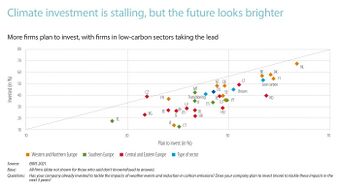
More than 1000 organizations with investments worth US$8 trillion have made commitments to fossil fuel divestment.[312] Socially responsible investing funds allow investors to invest in funds that meet high environmental, social and corporate governance (ESG) standards.[313]
Barriers

There are individual, institutional and market barriers to achieving climate change mitigation.[93]:5–71 They differ for all the different mitigation options, regions and societies.
Difficulties with accounting for carbon dioxide removal can act as economic barriers. This would apply to BECCS (bioenergy with carbon capture and storage).[46]:6–42 The strategies that companies follow can act as a barrier. But they can also accelerate decarbonisation.[93]:5–84
In order to decarbonise societies the state needs to play a predominant role. This is because it requires a massive coordination effort.[315]:213 This strong government role can only work well if there is social cohesion, political stability and trust.[315]:213
For land-based mitigation options, finance is a major barrier. Other barriers are cultural values, governance, accountability and institutional capacity.[316]:7-5
Developing countries face further barriers to mitigation.[317]
- The cost of capital increased in the early 2020s.[318] A lack of available capital and finance is common in developing countries.[319] Together with the absence of regulatory standards, this barrier supports the proliferation of inefficient equipment.
- There are also financial and capacity barrier in many of these countries.[93]:97
One study estimates that only 0.12% of all funding for climate-related research goes on the social science of climate change mitigation.[320] Vastly more funding goes on natural science studies of climate change. Considerable sums also go on studies of the impact of climate change and adaptation to it.[320]
Risks
Mitigation measures can also have negative side effects and risks.[92]:TS-133 In agriculture and forestry, mitigation measures can affect biodiversity and ecosystem functioning.[92]:TS-87 In renewable energy, mining for metals and minerals can increase threats to conservation areas.[321] There is some research into ways to recycle solar panels and electronic waste. This would create a source for materials so there is no need to mine them.[322][314]
Scholars have found that discussions about risks and negative side-effects of mitigation measures can lead to deadlock or the feeling that there are insuperable barriers to taking action.[314] A qualitative investigation of extreme weather events in a district of Sweden 1867-8 shows that public/ state incentives can mitigate starvation risk in the future.[323]
Impacts of the COVID-19 pandemic
The COVID-19 pandemic led some governments to shift their focus away from climate action, at least temporarily.[324] This obstacle to environmental policy efforts may have contributed to slowed investment in green energy technologies. The economic slowdown resulting from COVID-19 added to this effect.[325][326]
In 2020, carbon dioxide emissions fell by 6.4% or 2.3 billion tonnes globally.[327] Greenhouse gas emissions rebounded later in the pandemic as many countries began lifting restrictions. The direct impact of pandemic policies had a negligible long-term impact on climate change.[327][328]
Examples by country
2 emissions (by region, per capita). Vertical scale shows emissions per person, and areas of rectangles indicate total emissions for countries. Though China has larger emissions, the U.S. has more emissions per person.
2 per person than poorer (developing) countries.[329] Emissions are roughly proportional to GDP per person, though the rate of increase diminishes with average GDP/pp of about $10,000.
United States
China
China has committed to peak emissions by 2030 and reach net zero by 2060.[330] Warming cannot be limited to 1.5 °C if any coal plants in China (without carbon capture) operate after 2045.[331] The Chinese national carbon trading scheme started in 2021.
See also
- Attribution of recent climate change
- Carbon budget
- Carbon offsets and credits
- Carbon price
- Climate movement
- Climate change denial
- Nature-based solutions
- Pro-nuclear movement
- Tipping points in the climate system
References
- ↑ 1.0 1.1 1.2 1.3 1.4 1.5 1.6 IPCC, 2021: Annex VII: Glossary [Matthews, J.B.R., V. Möller, R. van Diemen, J.S. Fuglestvedt, V. Masson-Delmotte, C. Méndez, S. Semenov, A. Reisinger (eds.)]. In Climate Change 2021: The Physical Science Basis. Contribution of Working Group I to the Sixth Assessment Report of the Intergovernmental Panel on Climate Change [Masson-Delmotte, V., P. Zhai, A. Pirani, S.L. Connors, C. Péan, S. Berger, N. Caud, Y. Chen, L. Goldfarb, M.I. Gomis, M. Huang, K. Leitzell, E. Lonnoy, J.B.R. Matthews, T.K. Maycock, T. Waterfield, O. Yelekçi, R. Yu, and B. Zhou (eds.)]. Cambridge University Press, Cambridge, United Kingdom and New York, NY, USA, pp. 2215–2256, doi:10.1017/9781009157896.022.
- ↑ Chen, Lin; Msigwa, Goodluck; Yang, Mingyu; Osman, Ahmed I.; Fawzy, Samer; Rooney, David W.; Yap, Pow-Seng (2022). "Strategies to achieve a carbon neutral society: a review". Environmental Chemistry Letters 20 (4): 2277–2310. doi:10.1007/s10311-022-01435-8. PMID 35431715. Bibcode: 2022EnvCL..20.2277C.
- ↑ 3.0 3.1 Olivier J.G.J. and Peters J.A.H.W. (2020), Trends in global CO2 and total greenhouse gas emissions: 2020 report. PBL Netherlands Environmental Assessment Agency, The Hague.
- ↑ 4.0 4.1 4.2 "Sector by sector: where do global greenhouse gas emissions come from?". https://ourworldindata.org/ghg-emissions-by-sector.
- ↑ 5.0 5.1 5.2 5.3 5.4 5.5 5.6 5.7 IPCC (2022) Summary for policy makers in Climate Change 2022: Mitigation of Climate Change. Contribution of Working Group III to the Sixth Assessment Report of the Intergovernmental Panel on Climate Change, Cambridge University Press, Cambridge, United Kingdom and New York, NY, United States
- ↑ Ram M., Bogdanov D., Aghahosseini A., Gulagi A., Oyewo A.S., Child M., Caldera U., Sadovskaia K., Farfan J., Barbosa LSNS., Fasihi M., Khalili S., Dalheimer B., Gruber G., Traber T., De Caluwe F., Fell H.-J., Breyer C. Global Energy System based on 100% Renewable Energy – Power, Heat, Transport and Desalination Sectors . Study by Lappeenranta University of Technology and Energy Watch Group, Lappeenranta, Berlin, March 2019.
- ↑ "Cement – Analysis" (in en-GB). https://www.iea.org/reports/cement.
- ↑ 8.0 8.1 8.2 8.3 8.4 United Nations Environment Programme (2022). Emissions Gap Report 2022: The Closing Window — Climate crisis calls for rapid transformation of societies. Nairobi.
- ↑ Steuteville, Robert (2021-11-03). "Climate adaptation, mitigation, and urban design" (in en). https://www.cnu.org/publicsquare/2021/11/03/climate-adaptation-mitigation-and-urban-design.
- ↑ "Climate Change Performance Index". November 2022. http://www.indiaenvironmentportal.org.in/files/file/CCPI%202023.pdf.
- ↑ Ritchie, Hannah; Roser, Max; Rosado, Pablo (11 May 2020). "CO2 and Greenhouse Gas Emissions". Our World in Data. https://ourworldindata.org/co2-and-other-greenhouse-gas-emissions#future-emissions. Retrieved 27 August 2022.
- ↑ Harvey, Fiona (26 November 2019). "UN calls for push to cut greenhouse gas levels to avoid climate chaos". The Guardian. https://www.theguardian.com/environment/2019/nov/26/united-nations-global-effort-cut-emissions-stop-climate-chaos-2030.
- ↑ "Cut Global Emissions by 7.6 Percent Every Year for Next Decade to Meet 1.5°C Paris Target – UN Report". United Nations. https://unfccc.int/news/cut-global-emissions-by-76-percent-every-year-for-next-decade-to-meet-15degc-paris-target-un-report.
- ↑ IPCC (2022). Climate Change 2022: Mitigation of Climate Change. Contribution of Working Group III to the Sixth Assessment Report of the Intergovernmental Panel on Climate Change. Cambridge University Press. p. 300. https://www.ipcc.ch/report/ar6/wg3/.: The global benefits of pathways limiting warming to 2°C (>67%) outweigh global mitigation costs over the 21st century, if aggregated economic impacts of climate change are at the moderate to high end of the assessed range, and a weight consistent with economic theory is given to economic impacts over the long term. This holds true even without accounting for benefits in other sustainable development dimensions or nonmarket damages from climate change (medium confidence).
- ↑ "The crucial intersection between gender and climate" (in en). https://www.eib.org/en/stories/gender-climate.
- ↑ Nations, United. "Finance & Justice" (in en). https://www.un.org/en/climatechange/raising-ambition/climate-finance.
- ↑ 17.0 17.1 IPCC (2022) Chapter 1: Introduction and Framing in Climate Change 2022: Mitigation of Climate Change. Contribution of Working Group III to the Sixth Assessment Report of the Intergovernmental Panel on Climate Change, Cambridge University Press, Cambridge, United Kingdom and New York, NY, United States
- ↑ 18.0 18.1 Rogelj, J., D. Shindell, K. Jiang, S. Fifita, P. Forster, V. Ginzburg, C. Handa, H. Kheshgi, S. Kobayashi, E. Kriegler, L. Mundaca, R. Séférian, and M.V.Vilariño, 2018: Chapter 2: Mitigation Pathways Compatible with 1.5°C in the Context of Sustainable Development. In: Global Warming of 1.5°C. An IPCC Special Report on the impacts of global warming of 1.5°C above pre-industrial levels and related global greenhouse gas emission pathways, in the context of strengthening the global response to the threat of climate change, sustainable development, and efforts to eradicate poverty [Masson-Delmotte, V., P. Zhai, H.-O. Pörtner, D. Roberts, J. Skea, P.R. Shukla, A. Pirani, W. Moufouma-Okia, C. Péan, R. Pidcock, S. Connors, J.B.R. Matthews, Y. Chen, X. Zhou, M.I. Gomis, E. Lonnoy, T. Maycock, M. Tignor, and T. Waterfield (eds.)]. Cambridge University Press, Cambridge, UK and New York, NY, US, pp. 93-174. https://doi.org/10.1017/9781009157940.004.
- ↑ "What is solar radiation modification and what questions should SIDS be asking about the governance of its research and deployment?" (in en-gb). 21 October 2022. https://odi.org/en/insights/what-is-solar-radiation-modification-and-what-questions-should-sids-be-asking-about-the-governance-of-its-research-and-deployment/. "Solar radiation modification (SRM) – also discussed in the context of geoengineering – is part of a set of climate mitigation technologies"
- ↑ "Solar Radiation Modification: A Risk-Risk Analysis". https://www.c2g2.net/wp-content/uploads/202203-C2G-RR-Full.pdf.
- ↑ 21.0 21.1 IPCC (2022) Chapter 14: International cooperation in Climate Change 2022: Mitigation of Climate Change. Contribution of Working Group III to the Sixth Assessment Report of the Intergovernmental Panel on Climate Change, Cambridge University Press, Cambridge, United Kingdom and New York, NY, United States
- ↑ National Academies of Sciences, Engineering (25 March 2021) (in en). Reflecting Sunlight: Recommendations for Solar Geoengineering Research and Research Governance. doi:10.17226/25762. ISBN 978-0-309-67605-2. https://nap.nationalacademies.org/catalog/25762/reflecting-sunlight-recommendations-for-solar-geoengineering-research-and-research-governance.
- ↑ Olivier J.G.J. (2022), Trends in global CO2 and total greenhouse gas emissions: 2021 summary report . PBL Netherlands, Environmental Assessment Agency, The Hague.
- ↑ Friedlingstein, Pierre; O'Sullivan, Michael; Jones, Matthew W.; Andrew, Robbie M.; Hauck, Judith; Olsen, Are; Peters, Glen P.; Peters, Wouter et al. (2020). "Global Carbon Budget 2020" (in en). Earth System Science Data 12 (4): 3269–3340. doi:10.5194/essd-12-3269-2020. ISSN 1866-3516. Bibcode: 2020ESSD...12.3269F. https://essd.copernicus.org/articles/12/3269/2020/.
- ↑ "Chapter 2: Emissions trends and drivers". Ipcc_Ar6_Wgiii. 2022. https://report.ipcc.ch/ar6wg3/pdf/IPCC_AR6_WGIII_FinalDraft_Chapter02.pdf. Retrieved 2022-11-21.
- ↑ "It's critical to tackle coal emissions" (in en). 8 October 2021. https://blogs.worldbank.org/voices/its-critical-tackle-coal-emissions. "Coal power plants produce a fifth of global greenhouse gas emissions – more than any other single source."
- ↑ Ritchie, Hannah; Roser, Max; Rosado, Pablo (11 May 2020). "CO2 and Greenhouse Gas Emissions". Our World in Data. https://ourworldindata.org/greenhouse-gas-emissions.
- ↑ "Biden signs international climate deal on refrigerants" (in en). 27 October 2022. https://apnews.com/article/biden-business-china-rwanda-canada-922cd2519e517e1454e020a06d3cf881.
- ↑ "Methane vs. Carbon Dioxide: A Greenhouse Gas Showdown". 30 September 2014. http://www.onegreenplanet.org/animalsandnature/methane-vs-carbon-dioxide-a-greenhouse-gas-showdown/.
- ↑ Pérez-Domínguez, Ignacio; del Prado, Agustin; Mittenzwei, Klaus; Hristov, Jordan; Frank, Stefan; Tabeau, Andrzej; Witzke, Peter; Havlik, Petr et al. (December 2021). "Short- and long-term warming effects of methane may affect the cost-effectiveness of mitigation policies and benefits of low-meat diets" (in en). Nature Food 2 (12): 970–980. doi:10.1038/s43016-021-00385-8. ISSN 2662-1355. PMID 35146439.
- ↑ Franziska Funke; Linus Mattauch; Inge van den Bijgaart; H. Charles J. Godfray; Cameron Hepburn; David Klenert; Marco Springmann; Nicolas Treich (19 July 2022). "Toward Optimal Meat Pricing: Is It Time to Tax Meat Consumption?" (in en). Review of Environmental Economics and Policy 16 (2): 000. doi:10.1086/721078. "animal-based agriculture and feed crop production account for approximately 83 percent of agricultural land globally and are responsible for approximately 67 percent of deforestation (Poore and Nemecek 2018). This makes livestock farming the single largest driver of greenhouse gas (GHG) emissions, nutrient pollution, and ecosystem loss in the agricultural sector. A failure to mitigate GHG emissions from the food system, especially animal-based agriculture, could prevent the world from meeting the climate objective of limiting global warming to 1.5°C, as set forth in the Paris Climate Agreement, and complicate the path to limiting climate change to well below 2°C of warming (Clark et al. 2020).".
- ↑ IGSD (2013). "Short-Lived Climate Pollutants (SLCPs)". http://www.igsd.org/initiatives/slcps/.
- ↑ "How satellites could help hold countries to emissions promises made at COP26 summit". Washington Post. https://www.washingtonpost.com/climate-environment/2021/11/09/cop26-satellites-emissions/.
- ↑ "Satellites offer new ways to study ecosystems—and maybe even save them" (in en). https://www.science.org/content/article/satellites-offer-new-ways-study-ecosystems-maybe-even-save-them.
- ↑ "It's over for fossil fuels: IPCC spells out what's needed to avert climate disaster". 4 April 2022. https://www.theguardian.com/environment/2022/apr/04/its-over-for-fossil-fuels-ipcc-spells-out-whats-needed-to-avert-climate-disaster.
- ↑ "The evidence is clear: the time for action is now. We can halve emissions by 2030.". 4 April 2022. https://www.ipcc.ch/2022/04/04/ipcc-ar6-wgiii-pressrelease/.
- ↑ "Ambitious Action Key to Resolving Triple Planetary Crisis of Climate Disruption, Nature Loss, Pollution, Secretary-General Says in Message for International Mother Earth Day | Meetings Coverage and Press Releases". https://www.un.org/press/en/2022/sgsm21243.doc.htm.
- ↑ "Glasgow's 2030 credibility gap: net zero's lip service to climate action" (in en). https://climateactiontracker.org/publications/glasgows-2030-credibility-gap-net-zeros-lip-service-to-climate-action/.
- ↑ "Global Data Community Commits to Track Climate Action". https://unfccc.int/news/global-data-community-commits-to-track-climate-action.
- ↑ Nations, United. "Sustainable Development Goals Report 2020" (in en). United Nations. https://www.un.org/en/desa/sustainable-development-goals-report-2020.
- ↑ "World fails to meet a single target to stop destruction of nature – UN report" (in en). The Guardian. 15 September 2020. https://www.theguardian.com/environment/2020/sep/15/every-global-target-to-stem-destruction-of-nature-by-2020-missed-un-report-aoe.
- ↑ "Glasgow's 2030 credibility gap: net zero's lip service to climate action" (in en). https://climateactiontracker.org/publications/glasgows-2030-credibility-gap-net-zeros-lip-service-to-climate-action/.
- ↑ Mason, Jeff; Alper, Alexandra (18 September 2021). "Biden asks world leaders to cut methane in climate fight". Reuters. https://www.reuters.com/business/environment/biden-convenes-world-leaders-discuss-climate-change-ahead-glasgow-summit-2021-09-17/.
- ↑ Bassist, Rina (6 October 2021). "At OECD, Israel joins global battle against climate change". Al – Monitor. https://www.al-monitor.com/originals/2021/10/oecd-israel-joins-global-battle-against-climate-change.
- ↑ Friedlingstein, Pierre; Jones, Matthew W.; O'Sullivan, Michael; Andrew, Robbie M.; Hauck, Judith; Peters, Glen P.; Peters, Wouter; Pongratz, Julia et al. (2019). "Global Carbon Budget 2019". Earth System Science Data 11 (4): 1783–1838. doi:10.5194/essd-11-1783-2019. ISSN 1866-3508. Bibcode: 2019ESSD...11.1783F. https://essd.copernicus.org/articles/11/1783/2019/. Retrieved 15 February 2021.
- ↑ 46.0 46.1 46.2 46.3 Cite error: Invalid
<ref>tag; no text was provided for refs namedAR6 WGIII Ch 6 - ↑ 47.0 47.1 Teske, Sven, ed (2 August 2019). Achieving the Paris Climate Agreement Goals: Global and Regional 100% Renewable Energy Scenarios with Non-energy GHG Pathways for +1.5°C and +2°C. Springer Science+Business Media. doi:10.1007/978-3-030-05843-2. ISBN 978-3030058425. https://www.springer.com/de/book/9783030058425.
- ↑ "Global Energy Transformation: A Roadmap to 2050 (2019 edition)". International Renewable Energy Agency. https://www.irena.org/-/media/Files/IRENA/Agency/Publication/2019/Apr/IRENA_Global_Energy_Transformation_2019.pdf.
- ↑ "Share of cumulative power capacity by technology, 2010-2027". International Energy Agency (IEA). 5 December 2022. https://www.iea.org/data-and-statistics/charts/share-of-cumulative-power-capacity-by-technology-2010-2027. Source states "Fossil fuel capacity from IEA (2022), World Energy Outlook 2022. IEA. Licence: CC BY 4.0."
- ↑ "Scale-up of Solar and Wind Puts Existing Coal, Gas at Risk". BloombergNEF. 28 April 2020. https://about.bnef.com/blog/scale-up-of-solar-and-wind-puts-existing-coal-gas-at-risk.
- ↑ Emilio, Maurizio Di Paolo (2022-09-15). "The Cost of Energy, Key to Sustainability" (in en-US). https://www.powerelectronicsnews.com/why-the-cost-of-energy-is-key-to-sustainability/.
- ↑ Liebensteiner, Mario; Naumann, Fabian (2022-11-01). "Can carbon pricing counteract renewable energies' cannibalization problem?" (in en). Energy Economics 115: 106345. doi:10.1016/j.eneco.2022.106345. ISSN 0140-9883. https://www.sciencedirect.com/science/article/pii/S0140988322004741.
- ↑ Cartlidge, Edwin (18 November 2011). "Saving for a rainy day". Science 334 (6058): 922–24. doi:10.1126/science.334.6058.922. PMID 22096185. Bibcode: 2011Sci...334..922C.
- ↑ "Renewable power's growth is being turbocharged as countries seek to strengthen energy security" (in en-GB). 6 December 2022. https://www.iea.org/news/renewable-power-s-growth-is-being-turbocharged-as-countries-seek-to-strengthen-energy-security. "Utility-scale solar PV and onshore wind are the cheapest options for new electricity generation in a significant majority of countries worldwide."
- ↑ "Solar - Fuels & Technologies" (in en-GB). https://www.iea.org/fuels-and-technologies/solar. "utility-scale solar PV is the least costly option for new electricity generation in a significant majority of countries worldwide"
- ↑ Jaeger, Joel (20 September 2021). "Explaining the Exponential Growth of Renewable Energy" (in en). https://www.wri.org/insights/growth-renewable-energy-sector-explained.
- ↑ Wanner, Brent. "Is exponential growth of solar PV the obvious conclusion?". IEA. https://www.iea.org/commentaries/is-exponential-growth-of-solar-pv-the-obvious-conclusion.
- ↑ "Renewables 2021 Global Status Report". REN21. pp. 137–138. https://www.ren21.net/wp-content/uploads/2019/05/GSR2021_Full_Report.pdf.
- ↑ "Global Wind Atlas". DTU Technical University of Denmark. http://science.globalwindatlas.info/datasets.html.
- ↑ "Onshore vs offshore wind energy: what's the difference? | National Grid Group" (in en). https://www.nationalgrid.com/stories/energy-explained/onshore-vs-offshore-wind-energy.
- ↑ Nyenah, Emmanuel; Sterl, Sebastian; Thiery, Wim (1 May 2022). "Pieces of a puzzle: solar-wind power synergies on seasonal and diurnal timescales tend to be excellent worldwide". Environmental Research Communications 4 (5): 055011. doi:10.1088/2515-7620/ac71fb. ISSN 2515-7620. Bibcode: 2022ERCom...4e5011N.
- ↑ "BP Statistical Review 2019". https://www.bp.com/content/dam/bp/business-sites/en/global/corporate/pdfs/energy-economics/statistical-review/bp-stats-review-2019-full-report.pdf.
- ↑ "Large hydropower dams not sustainable in the developing world". BBC News. 5 November 2018. https://www.bbc.com/news/science-environment-46098118.
- ↑ "From baseload to peak". IRENA. https://www.irena.org/-/media/Files/IRENA/Agency/Publication/2015/IRENA_Baseload_to_Peak_2015.pdf.
- ↑ "Biomass – Carbon sink or carbon sinner". UK environment agency. https://fcrn.org.uk/sites/default/files/Biomass__carbon_sink_or_carbon_sinner_summary_report.pdf.
- ↑ "Virgin Atlantic purchases 10 million gallons of SAF from Gevo" (in en-US). 7 December 2022. https://biofuels-news.com/news/virgin-atlantic-purchases-10-million-gallons-of-saf-from-gevo/.
- ↑ Geothermal Energy Association. Geothermal Energy: International Market Update May 2010, p. 4-6.
- ↑ Bassam, Nasir El; Maegaard, Preben; Schlichting, Marcia (2013) (in en). Distributed Renewable Energies for Off-Grid Communities: Strategies and Technologies Toward Achieving Sustainability in Energy Generation and Supply. Newnes. pp. 187. ISBN 978-0-12-397178-4. https://books.google.com/books?id=uP4eGFt4c_AC&q=international+Geothermal+Association+10,715+megawatts&pg=PA187.
- ↑ Moomaw, W., P. Burgherr, G. Heath, M. Lenzen, J. Nyboer, A. Verbruggen, 2011: Annex II: Methodology. In IPCC: Special Report on Renewable Energy Sources and Climate Change Mitigation (ref. page 10)
- ↑ Ruggles, Tyler H.; Caldeira, Ken (1 January 2022). "Wind and solar generation may reduce the inter-annual variability of peak residual load in certain electricity systems" (in en). Applied Energy 305: 117773. doi:10.1016/j.apenergy.2021.117773. ISSN 0306-2619. Bibcode: 2022ApEn..30517773R.
- ↑ "You've heard of water droughts. Could 'energy' droughts be next?" (in en). https://www.sciencedaily.com/releases/2022/04/220412161551.htm.
- ↑ United Nations Environment Programme (2019). Emissions Gap Report 2019. United Nations Environment Programme. p. 47. ISBN 978-92-807-3766-0. https://wedocs.unep.org/bitstream/handle/20.500.11822/30797/EGR2019.pdf?sequence=1&isAllowed=y.
- ↑ "Introduction to System Integration of Renewables". IEA. https://www.iea.org/reports/introduction-to-system-integration-of-renewables.
- ↑ 74.0 74.1 74.2 Blanco, Herib; Faaij, André (2018). "A review at the role of storage in energy systems with a focus on Power to Gas and long-term storage". Renewable and Sustainable Energy Reviews 81: 1049–1086. doi:10.1016/j.rser.2017.07.062. ISSN 1364-0321.
- ↑ REN21 (2020). Renewables 2020: Global Status Report. REN21 Secretariat. p. 177. ISBN 978-3-948393-00-7. https://www.ren21.net/wp-content/uploads/2019/05/gsr_2020_full_report_en.pdf.
- ↑ Bloess, Andreas; Schill, Wolf-Peter; Zerrahn, Alexander (2018). "Power-to-heat for renewable energy integration: A review of technologies, modeling approaches, and flexibility potentials". Applied Energy 212: 1611–1626. doi:10.1016/j.apenergy.2017.12.073. Bibcode: 2018ApEn..212.1611B.
- ↑ IEA (2020). World Energy Outlook 2020. International Energy Agency. p. 109. ISBN 978-92-64-44923-7. https://www.iea.org/reports/world-energy-outlook-2020.
- ↑ 78.0 78.1 Koohi-Fayegh, S.; Rosen, M.A. (2020). "A review of energy storage types, applications and recent developments". Journal of Energy Storage 27: 101047. doi:10.1016/j.est.2019.101047. ISSN 2352-152X. https://www.sciencedirect.com/science/article/pii/S2352152X19306012. Retrieved 28 November 2020.
- ↑ Katz, Cheryl (17 December 2020). "The batteries that could make fossil fuels obsolete". BBC. https://www.bbc.com/future/article/20201217-renewable-power-the-worlds-largest-battery.
- ↑ Herib, Blanco; André, Faaij (2018). "A review at the role of storage in energy systems with a focus on Power to Gas and long-term storage". Renewable and Sustainable Energy Reviews 81: 1049–1086. doi:10.1016/j.rser.2017.07.062. ISSN 1364-0321.
- ↑ "Climate change and batteries: the search for future power storage solutions". Climate change: science and solutions. The Royal Society. 19 May 2021. https://royalsociety.org/-/media/policy/projects/climate-change-science-solutions/climate-science-solutions-batteries.pdf. Retrieved 15 October 2021.
- ↑ Hunt, Julian D.; Byers, Edward; Wada, Yoshihide; Parkinson, Simon et al. (2020). "Global resource potential of seasonal pumped hydropower storage for energy and water storage". Nature Communications 11 (1): 947. doi:10.1038/s41467-020-14555-y. ISSN 2041-1723. PMID 32075965. Bibcode: 2020NatCo..11..947H.
- ↑ "Climate Change and Nuclear Power 2022" (in en). 19 August 2020. https://www.iaea.org/topics/nuclear-power-and-climate-change/climate-change-and-nuclear-power-2022.
- ↑ "World Nuclear Waste Report". https://worldnuclearwastereport.org/.
- ↑ Smith, Brice. "Insurmountable Risks: The Dangers of Using Nuclear Power to Combat Global Climate Change – Institute for Energy and Environmental Research" (in en). https://ieer.org/resource/books/insurmountable-risks-dangers-nuclear/.
- ↑ Prăvălie, Remus; Bandoc, Georgeta (2018). "Nuclear energy: Between global electricity demand, worldwide decarbonisation imperativeness, and planetary environmental implications" (in en). Journal of Environmental Management 209: 81–92. doi:10.1016/j.jenvman.2017.12.043. PMID 29287177. https://linkinghub.elsevier.com/retrieve/pii/S0301479717312227.
- ↑ Schneider, Mycle; Froggatt, Antony. World Nuclear Industry Status Report 2021 (Report). https://www.worldnuclearreport.org/IMG/pdf/wnisr2021-lr.pdf. Retrieved 1 January 2023.
- ↑ 88.0 88.1 "Nuclear Power Is Declining in the West and Growing in Developing Countries" (in en-US). https://www.brinknews.com/nuclear-power-is-declining-in-the-west-and-growing-in-developing-countries/.
- ↑ "May: Steep decline in nuclear power would threaten energy security and climate goals". https://www.iea.org/newsroom/news/2019/may/steep-decline-in-nuclear-power-would-threaten-energy-security-and-climate-goals.html.
- ↑ "Factoring the Costs of Severe Nuclear Accidents into Backfit Decisions". Lessons Learned from the Fukushima Nuclear Accident for Improving Safety of U.S. Nuclear Plants (Appendix L - Factoring the Costs of Severe Nuclear Accidents into Backfit Decisions). National Research Council. 2014. https://www.ncbi.nlm.nih.gov/books/NBK253929/. Retrieved 29 December 2023.
- ↑ Carman, Jennifer; Goldberg, Matthew; Marlon, Jennifer; Wang, Xinran; Lacroix, Karine; Neyens, Liz; Leiserowitz, Anthony; Maibach, Edward et al. (Aug 3, 2021). "Americans' Actions to Limit and Prepare For Global Warming". Americans' Actions to Limit and Prepare for Global Warming, March 2021 March 2021.
- ↑ 92.0 92.1 92.2 92.3 92.4 92.5 92.6 92.7 92.8 92.9 IPCC (2022) Technical Summary. In Climate Change 2022: Mitigation of Climate Change. Contribution of Working Group III to the Sixth Assessment Report of the Intergovernmental Panel on Climate Change, Cambridge University Press, Cambridge, United Kingdom and New York, NY, United States
- ↑ 93.0 93.1 93.2 93.3 93.4 93.5 Patrick Devine-Wright, Julio Diaz-José, Frank Geels, Arnulf Grubler, Nadia Maïzi, Eric Masanet, Yacob Mulugetta, Chioma Daisy Onyige-Ebeniro, Patricia E. Perkins, Alessandro Sanches Pereira, Elke Ursula Weber (2022) Chapter 5: Demand, services and social aspects of mitigation in Climate Change 2022: Mitigation of Climate Change. Contribution of Working Group III to the Sixth Assessment Report of the Intergovernmental Panel on Climate Change, Cambridge University Press, Cambridge, United Kingdom and New York, NY, United States
- ↑ "Economic growth no longer means higher carbon emissions". The Economist. ISSN 0013-0613. https://www.economist.com/finance-and-economics/2022/11/08/economic-growth-no-longer-means-higher-carbon-emissions.
- ↑ "2021-2022 EIB Climate Survey, part 3 of 3: The economic and social impact of the green transition" (in en). https://www.eib.org/en/surveys/climate-survey/4th-climate-survey/green-transition-jobs-lifestyle-adaptation.htm.
- ↑ Richard Hughes, Ben; Kaiser Calautit, John; Abdul Ghani, Saud (April 2012). "The development of commercial wind towers for natural ventilation: A review". Applied Energy 92: 606. doi:10.1016/j.apenergy.2011.11.066. Bibcode: 2012ApEn...92..606H. https://www.sciencedirect.com/science/article/abs/pii/S0306261911007720. Retrieved 28 August 2023.
- ↑ Nouh Ma’bdeh, Shouib; Fawwaz Alrebei, Odi; M. Obeidat, Laith; Al-Radaideh, Tamer; Kaouri, Katerina; I. Amhamed, Abdulkarem (29 December 2022). "Quantifying Energy Reduction and Thermal Comfort for a Residential Building Ventilated with a Window-Windcatcher: A Case Study". Buildings 13: 86. doi:10.3390/buildings13010086.
- ↑ IEA (2019), Global Energy & CO2 Status Report 2019, IEA, Paris, License: CC BY 4.0
- ↑ Key World Energy Statistics 2020 (Report). IEA. 2020. https://www.iea.org/reports/key-world-energy-statistics-2020/final-consumption.
- ↑ "A guide for effective energy saving". 9 April 2015. http://www.renewableenergyworld.com/ugc/blogs/2015/04/a-guide-for-effective-energy-saving.html.
- ↑ "The value of urgent action on energy efficiency – Analysis" (in en-GB). https://www.iea.org/reports/the-value-of-urgent-action-on-energy-efficiency.
- ↑ Diesendorf, Mark (2007). Greenhouse Solutions with Sustainable Energy, UNSW Press, p. 86.
- ↑ 103.0 103.1 "Emissions Gap Report 2020 / Executive Summary". United Nations Environment Programme. 2021. p. XV Fig. ES.8. https://wedocs.unep.org/bitstream/handle/20.500.11822/34438/EGR20ESE.pdf.
- ↑ Climate Equality: a Climate for the 99%. Oxfam International. November 2023. https://webassets.oxfamamerica.org/media/documents/cr-climate-equality-201123-en.pdf. Fig. ES.2, Fig. ES.3, Box 1.2.
- ↑ Wolf, C.; Ripple, W.J.; Crist, E. (2021). "Human population, social justice, and climate policy". Sustainability Science 16 (5): 1753–1756. doi:10.1007/s11625-021-00951-w. Bibcode: 2021SuSc...16.1753W.
- ↑ Crist, Eileen; Ripple, William J.; Ehrlich, Paul R.; Rees, William E.; Wolf, Christopher (2022). "Scientists' warning on population". Science of the Total Environment 845: 157166. doi:10.1016/j.scitotenv.2022.157166. PMID 35803428. Bibcode: 2022ScTEn.845o7166C. https://scientistswarning.forestry.oregonstate.edu/sites/default/files/Crist2022.pdf. ""Our first action call is a direct, global appeal to all women and men to choose none or at most one child. Individuals, especially if they aspire to large families, may pursue adoption, which is a desirable and compassionate choice for children who are here and need to be cared for."".
- ↑ "Six key lifestyle changes can help avert the climate crisis, study finds" (in en). 7 March 2022. https://www.theguardian.com/environment/2022/mar/07/six-key-lifestyle-changes-can-help-avert-the-climate-crisis-study-finds.
- ↑ Adcock, Bronwyn (2022). "Electric Monaros and hotted-up skateboards : the 'genius' who wants to electrify our world" (in en). https://www.theguardian.com/australia-news/2022/feb/05/electric-monaros-and-hotted-up-skateboards-the-genius-who-wants-to-electrify-our-world.
- ↑ 109.0 109.1 Ripple, William J. et al. (2013). "Ruminants, climate change and climate policy". Nature Climate Change 4 (1): 2–5. doi:10.1038/nclimate2081. Bibcode: 2014NatCC...4....2R. https://trophiccascades.forestry.oregonstate.edu/sites/trophic/files/Ripple_2014_NCC.pdf.
- ↑ "COP26: How can an average family afford an electric car? And more questions" (in en-GB). BBC News. 11 November 2021. https://www.bbc.com/news/science-environment-58925049.
- ↑ "Emissions inequality—a gulf between global rich and poor – Nicholas Beuret" (in en-GB). 10 April 2019. https://www.socialeurope.eu/emissions-inequality.
- ↑ Westlake, Steve (11 April 2019). "Climate change: yes, your individual action does make a difference" (in en). http://theconversation.com/climate-change-yes-your-individual-action-does-make-a-difference-115169.
- ↑ "Avoiding meat and dairy is 'single biggest way' to reduce your impact on Earth" (in en). 31 May 2018. http://www.theguardian.com/environment/2018/may/31/avoiding-meat-and-dairy-is-single-biggest-way-to-reduce-your-impact-on-earth.
- ↑ Harvey, Fiona (21 March 2016). "Eat less meat to avoid dangerous global warming, scientists say". The Guardian. https://www.theguardian.com/environment/2016/mar/21/eat-less-meat-vegetarianism-dangerous-global-warming.
- ↑ Milman, Oliver (20 June 2016). "China's plan to cut meat consumption by 50% cheered by climate campaigners". The Guardian. https://www.theguardian.com/world/2016/jun/20/chinas-meat-consumption-climate-change.
- ↑ Schiermeier, Quirin (8 August 2019). "Eat less meat: UN climate-change report calls for change to human diet". Nature 572 (7769): 291–292. doi:10.1038/d41586-019-02409-7. PMID 31409926. Bibcode: 2019Natur.572..291S.
- ↑ Harvey, Fiona (4 April 2022). "Final warning: what does the IPCC's third report instalment say?". The Guardian. https://www.theguardian.com/environment/2022/apr/04/final-warning-what-does-the-ipcc-third-report-instalment-say.
- ↑ "How plant-based diets not only reduce our carbon footprint, but also increase carbon capture" (in en). Leiden University. https://phys.org/news/2022-01-plant-based-diets-carbon-footprint-capture.html.
- ↑ Sun, Zhongxiao; Scherer, Laura; Tukker, Arnold; Spawn-Lee, Seth A.; Bruckner, Martin; Gibbs, Holly K.; Behrens, Paul (January 2022). "Dietary change in high-income nations alone can lead to substantial double climate dividend" (in en). Nature Food 3 (1): 29–37. doi:10.1038/s43016-021-00431-5. ISSN 2662-1355. PMID 37118487. https://www.researchgate.net/publication/357723207.
- ↑ Carrington, Damian (21 July 2023). "Vegan diet massively cuts environmental damage, study shows". The Guardian. https://www.theguardian.com/environment/2023/jul/20/vegan-diet-cuts-environmental-damage-climate-heating-emissions-study.
- ↑ "Carbon Sources and Sinks" (in en). 2020-03-26. http://www.nationalgeographic.org/encyclopedia/carbon-sources-and-sinks/.
- ↑ Levin, Kelly (8 August 2019). "How Effective Is Land At Removing Carbon Pollution? The IPCC Weighs In" (in en). World Resources Institute. https://www.wri.org/insights/how-effective-land-removing-carbon-pollution-ipcc-weighs.
- ↑ Hoegh-Guldberg, O., D. Jacob, M. Taylor, M. Bindi, S. Brown, I. Camilloni, A. Diedhiou, R. Djalante, K.L. Ebi, F. Engelbrecht, J.Guiot, Y. Hijioka, S. Mehrotra, A. Payne, S.I. Seneviratne, A. Thomas, R. Warren, and G. Zhou, 2018: Chapter 3: Impacts of 1.5°C Global Warming on Natural and Human Systems. In: Global Warming of 1.5°C. An IPCC Special Report on the impacts of global warming of 1.5°C above pre-industrial levels and related global greenhouse gas emission pathways, in the context of strengthening the global response to the threat of climate change, sustainable development, and efforts to eradicate poverty [Masson-Delmotte, V., P. Zhai, H.-O. Pörtner, D. Roberts, J. Skea, P.R. Shukla, A. Pirani, W. Moufouma-Okia, C. Péan, R. Pidcock, S. Connors, J.B.R. Matthews, Y. Chen, X. Zhou, M.I. Gomis, E. Lonnoy, T.Maycock, M.Tignor, and T. Waterfield (eds.)]. Cambridge University Press, Cambridge, UK and New York, NY, US, pp. 175-312. https://doi.org/10.1017/9781009157940.005.
- ↑ Bui, Mai; Adjiman, Claire S.; Bardow, André; Anthony, Edward J.; Boston, Andy; Brown, Solomon; Fennell, Paul S.; Fuss, Sabine et al. (2018). "Carbon capture and storage (CCS): the way forward" (in en). Energy & Environmental Science 11 (5): 1062–1176. doi:10.1039/C7EE02342A. ISSN 1754-5692. http://xlink.rsc.org/?DOI=C7EE02342A.
- ↑ 125.0 125.1 IPCC, 2018: Summary for Policymakers. In: Global Warming of 1.5°C. An IPCC Special Report on the impacts of global warming of 1.5°C above pre-industrial levels and related global greenhouse gas emission pathways, in the context of strengthening the global response to the threat of climate change, sustainable development, and efforts to eradicate poverty [Masson-Delmotte, V., P. Zhai, H.-O. Pörtner, D. Roberts, J. Skea, P.R. Shukla, A. Pirani, W. Moufouma-Okia, C. Péan, R. Pidcock, S. Connors, J.B.R. Matthews, Y. Chen, X. Zhou, M.I. Gomis, E. Lonnoy, T. Maycock, M. Tignor, and T. Waterfield (eds.)]. Cambridge University Press, Cambridge, UK and New York, NY, US, pp. 3-24. https://doi.org/10.1017/9781009157940.001.
- ↑ IPCC, 2018: Global Warming of 1.5°C. An IPCC Special Report on the impacts of global warming of 1.5°C above pre-industrial levels and related global greenhouse gas emission pathways, in the context of strengthening the global response to the threat of climate change, sustainable development, and efforts to eradicate poverty [Masson-Delmotte, V., P. Zhai, H.-O. Pörtner, D. Roberts, J. Skea, P.R. Shukla, A. Pirani, W. Moufouma-Okia, C. Péan, R. Pidcock, S. Connors, J.B.R. Matthews, Y. Chen, X. Zhou, M.I. Gomis, E. Lonnoy, T. Maycock, M. Tignor, and T. Waterfield (eds.)]. In Press.
- ↑ Stern, Nicholas Herbert (2007). The economics of climate change: the Stern review. Cambridge, UK: Cambridge University Press. p. xxv. ISBN 978-0-521-70080-1. http://www.hm-treasury.gov.uk/independent_reviews/stern_review_economics_climate_change/stern_review_report.cfm. Retrieved 2009-12-28.
- ↑ Ritchie, Hannah; Roser, Max (9 February 2021). "Forests and Deforestation". Our World in Data. https://ourworldindata.org/drivers-of-deforestation.
- ↑ 129.0 129.1 "India should follow China to find a way out of the woods on saving forest people". The Guardian. 22 July 2016. https://www.theguardian.com/global-development/2016/jul/22/india-follow-china-saving-forest-people-land-rights.
- ↑ "How Conservation Became Colonialism". Foreign Policy. 16 July 2018. https://foreignpolicy.com/2018/07/16/how-conservation-became-colonialism-environment-indigenous-people-ecuador-mining/. Retrieved 30 July 2018.
- ↑ Moomaw, William R.; Masino, Susan A.; Faison, Edward K. (2019). "Intact Forests in the United States: Proforestation Mitigates Climate Change and Serves the Greatest Good". Frontiers in Forests and Global Change 2: 27. doi:10.3389/ffgc.2019.00027. Bibcode: 2019FrFGC...2...27M.
- ↑ 132.0 132.1 "New Jungles Prompt a Debate on Rain Forests". New York Times. 29 January 2009. https://www.nytimes.com/2009/01/30/science/earth/30forest.html?pagewanted=all.
- ↑ 133.0 133.1 133.2 "The natural world can help save us from climate catastrophe | George Monbiot". 3 April 2019. http://www.theguardian.com/commentisfree/2019/apr/03/natural-world-climate-catastrophe-rewilding.
- ↑ Wilmers, Christopher C.; Schmitz, Oswald J. (19 October 2016). "Effects of gray wolf-induced trophic cascades on ecosystem carbon cycling". Ecosphere 7 (10). doi:10.1002/ecs2.1501. Bibcode: 2016Ecosp...7E1501W.
- ↑ van Minnen, Jelle G; Strengers, Bart J; Eickhout, Bas; Swart, Rob J; Leemans, Rik (2008). "Quantifying the effectiveness of climate change mitigation through forest plantations and carbon sequestration with an integrated land-use model". Carbon Balance and Management 3 (1): 3. doi:10.1186/1750-0680-3-3. ISSN 1750-0680. PMID 18412946. Bibcode: 2008CarBM...3....3V.
- ↑ Boysen, Lena R.; Lucht, Wolfgang; Gerten, Dieter; Heck, Vera; Lenton, Timothy M.; Schellnhuber, Hans Joachim (17 May 2017). "The limits to global-warming mitigation by terrestrial carbon removal". Earth's Future 5 (5): 463–474. doi:10.1002/2016EF000469. Bibcode: 2017EaFut...5..463B.
- ↑ Yoder, Kate (12 May 2022). "Does planting trees actually help the climate? Here's what we know.". Grist. https://www.rewildingmag.com/does-planting-trees-help-climate-change/.
- ↑ "One trillion trees - uniting the world to save forests and climate" (in en). 22 January 2020. https://www.weforum.org/agenda/2020/01/one-trillion-trees-world-economic-forum-launches-plan-to-help-nature-and-the-climate/.
- ↑ Gabbatiss, Josh (16 February 2019). "Massive restoration of world's forests would cancel out a decade of CO
2 emissions, analysis suggests". Independent. https://www.independent.co.uk/climate-change/news/forests-climate-change-co2-greenhouse-gases-trillion-trees-global-warming-a8782071.html. - ↑ 140.0 140.1 140.2 "The Great Green Wall: African Farmers Beat Back Drought and Climate Change with Trees". Scientific America. 28 January 2011. https://www.scientificamerican.com/article/farmers-in-sahel-beat-back-drought-and-climate-change-with-trees/.
- ↑ 141.0 141.1 "In semi-arid Africa, farmers are transforming the "underground forest" into life-giving trees". University of Minnesote. 28 January 2011. https://ensia.com/features/in-semi-arid-africa-farmers-are-transforming-the-underground-forest-into-life-giving-trees/.
- ↑ 142.0 142.1 142.2 Stern, N. (2006). Stern Review on the Economics of Climate Change: Part III: The Economics of Stabilisation. HM Treasury, London: http://hm-treasury.gov.uk/sternreview_index.htm
- ↑ Chazdon, Robin; Brancalion, Pedro (5 July 2019). "Restoring forests as a means to many ends" (in en). Science 365 (6448): 24–25. doi:10.1126/science.aax9539. ISSN 0036-8075. PMID 31273109. Bibcode: 2019Sci...365...24C.
- ↑ Young, E. (2008). IPCC Wrong On Logging Threat to Climate. New Scientist, 5 August 2008. Retrieved on 18 August 2008, from https://www.newscientist.com/article/dn14466-ipcc-wrong-on-logging-threat-toclimate.html
- ↑ "In Latin America, Forests May Rise to Challenge of Carbon Dioxide". New York Times. 16 May 2016. https://www.nytimes.com/2016/05/17/science/forests-carbon-dioxide.html?_r=1.
- ↑ Song, Shanshan; Ding, Yali; Li, Wei (10 February 2023). "Mangrove reforestation provides greater blue carbon benefit than afforestation for mitigating global climate change". Nature Communications 14 (1): 11. doi:10.1038/s41467-023-36477-1. PMID 36765059. PMC 9918466. Bibcode: 2023NatCo..14..756S. https://rdcu.be/da3Rm. Retrieved 28 April 2023.
- ↑ (in en-US) Securing Rights, Combating Climate Change. World Resources Institute. ISBN 978-1569738290. https://www.wri.org/research/securing-rights-combating-climate-change. Retrieved 2 June 2022.
- ↑ "Community forestry can work, but plans in the Democratic Republic of Congo show what's missing" (in en-US). 29 June 2020. https://theconversation.com/community-forestry-can-work-but-plans-in-the-democratic-republic-of-congo-show-whats-missing-138625.
- ↑ "What to consider when increasing soil carbon stocks" (in en-US). 14 February 2022. https://www.fwi.co.uk/arable/land-preparation/soils/what-to-consider-when-increasing-soil-carbon-stocks. "many factors can affect how easy it is for micro-organisms to access carbon"
- ↑ Terrer, C.; Phillips, R. P.; Hungate, B. A.; Rosende, J.; Pett-Ridge, J.; Craig, M. E.; van Groenigen, K. J.; Keenan, T. F. et al. (March 2021). "A trade-off between plant and soil carbon storage under elevated CO
2" (in en). Nature 591 (7851): 599–603. doi:10.1038/s41586-021-03306-8. ISSN 1476-4687. PMID 33762765. Bibcode: 2021Natur.591..599T. https://www.nature.com/articles/s41586-021-03306-8. "Although plant biomass often increases in elevated CO
2 (eCO
2) experiments SOC has been observed to increase, remain unchanged or even decline. The mechanisms that drive this variation across experiments remain poorly understood, creating uncertainty in climate projections". - ↑ "Carbon farming explained: the pros, the cons and the EU's plans" (in en). 17 March 2022. https://www.cleanenergywire.org/factsheets/carbon-farming-explained-pros-cons-and-eus-plans. "But many German researchers and the country's agriculture ministry warn that soil carbon sequestration is easily reversible, hard to measure, and could lead to greenwashing. Existing frameworks for carbon farming certificates deploy a wide variety of approaches to quantifying the amount of carbon removals, the European Commission says."
- ↑ 152.0 152.1 Harris, Nancy; Gibbs, David (21 January 2021). "Forests Absorb Twice As Much Carbon As They Emit Each Year" (in en). https://www.wri.org/insights/forests-absorb-twice-much-carbon-they-emit-each-year.
- ↑ Rosane, Olivia (18 March 2020). "Protecting and Restoring Soils Could Remove 5.5 Billion Tonnes of CO
2 a Year". Ecowatch. https://www.ecowatch.com/soil-protection-co2-2645518371.html. - ↑ Lang, Susan S. (13 July 2005). "Organic farming produces same corn and soybean yields as conventional farms, but consumes less energy and no pesticides, study finds". http://www.news.cornell.edu/stories/July05/organic.farm.vs.other.ssl.html.
- ↑ Pimentel, David; Hepperly, Paul; Hanson, James; Douds, David; Seidel, Rita (2005). "Environmental, Energetic, and Economic Comparisons of Organic and Conventional Farming Systems". BioScience 55 (7): 573–82. doi:10.1641/0006-3568(2005)055[0573:EEAECO2.0.CO;2].
- ↑ Lal, Rattan; Griffin, Michael; Apt, Jay; Lave, Lester; Morgan, M. Granger (2004). "Ecology: Managing Soil Carbon". Science 304 (5669): 393. doi:10.1126/science.1093079. PMID 15087532.
- ↑ Amelung, W.; Bossio, D.; de Vries, W.; Kögel-Knabner, I.; Lehmann, J.; Amundson, R.; Bol, R.; Collins, C. et al. (27 October 2020). "Towards a global-scale soil climate mitigation strategy" (in en). Nature Communications 11 (1): 5427. doi:10.1038/s41467-020-18887-7. ISSN 2041-1723. PMID 33110065. Bibcode: 2020NatCo..11.5427A.
- ↑ Papanicolaou, A. N. (Thanos); Wacha, Kenneth M.; Abban, Benjamin K.; Wilson, Christopher G.; Hatfield, Jerry L.; Stanier, Charles O.; Filley, Timothy R. (2015). "Conservation Farming Shown to Protect Carbon in Soil". Journal of Geophysical Research: Biogeosciences 120 (11): 2375–2401. doi:10.1002/2015JG003078. Bibcode: 2015JGRG..120.2375P. https://eos.org/research-spotlights/conservation-farming-shown-to-protect-carbon-in-soil.
- ↑ "Cover Crops, a Farming Revolution With Deep Roots in the Past". The New York Times. 2016. https://www.nytimes.com/2016/02/07/business/cover-crops-a-farming-revolution-with-deep-roots-in-the-past.html?_r=0.
- ↑ Lugato, Emanuele; Bampa, Francesca; Panagos, Panos; Montanarella, Luca; Jones, Arwyn (1 November 2014). "Potential carbon sequestration of European arable soils estimated by modelling a comprehensive set of management practices". Global Change Biology 20 (11): 3557–3567. doi:10.1111/gcb.12551. ISSN 1365-2486. PMID 24789378. Bibcode: 2014GCBio..20.3557L.
- ↑ Teague, W. R.; Apfelbaum, S.; Lal, R.; Kreuter, U. P.; Rowntree, J.; Davies, C. A.; Conser, R.; Rasmussen, M. et al. (1 March 2016). "The role of ruminants in reducing agriculture's carbon footprint in North America" (in en). Journal of Soil and Water Conservation 71 (2): 156–164. doi:10.2489/jswc.71.2.156. ISSN 0022-4561.
- ↑ Scanlon, Kerry (18 October 2018). "Trends in Sustainability: Regenerative Agriculture". https://www.rainforest-alliance.org/business/blog/2018/10/18/trends-in-sustainability-regenerative-agriculture/.
- ↑ "What Is Regenerative Agriculture?". The Climate Reality Project. Ecowatch. 2 July 2019. https://www.ecowatch.com/regenerative-agriculture-2639054637.html.
- ↑ 164.0 164.1 Lehmann, Johannes; Cowie, Annette; Masiello, Caroline A.; Kammann, Claudia; Woolf, Dominic; Amonette, James E.; Cayuela, Maria L.; Camps-Arbestain, Marta et al. (2021). "Biochar in climate change mitigation" (in en). Nature Geoscience 14 (12): 883–892. doi:10.1038/s41561-021-00852-8. ISSN 1752-0908. Bibcode: 2021NatGe..14..883L. https://www.nature.com/articles/s41561-021-00852-8.
- ↑ Dominic Woolf; James E. Amonette; F. Alayne Street-Perrott; Johannes Lehmann; Stephen Joseph (August 2010). "Sustainable biochar to mitigate global climate change". Nature Communications 1 (5): 56. doi:10.1038/ncomms1053. ISSN 2041-1723. PMID 20975722. Bibcode: 2010NatCo...1...56W.
- ↑ Synthesis of Adaptation Options for Coastal Areas. Climate Ready Estuaries Program, EPA 430-F-08-024. Washington, DC: US Environmental Protection Agency. 2009.
- ↑ "Coastal Wetland Protection" (in en). 6 February 2020. https://drawdown.org/solutions/coastal-wetland-protection.
- ↑ Chmura, G. L. (2003). "Global carbon sequestration in tidal, saline wetland soils". Global Biogeochemical Cycles 17 (4): Abstract. doi:10.1029/2002GB001917. Bibcode: 2003GBioC..17.1111C.
- ↑ Tiwari, Shashank; Singh, Chhatarpal; Singh, Jay Shankar (2020). "Wetlands: A Major Natural Source Responsible for Methane Emission". in Upadhyay, Atul Kumar; Singh, Ranjan; Singh, D. P. (in en). Restoration of Wetland Ecosystem: A Trajectory Towards a Sustainable Environment. Singapore: Springer. pp. 59–74. doi:10.1007/978-981-13-7665-8_5. ISBN 978-981-13-7665-8.
- ↑ Bange, Hermann W. (2006). "Nitrous oxide and methane in European coastal waters" (in en). Estuarine, Coastal and Shelf Science 70 (3): 361–374. doi:10.1016/j.ecss.2006.05.042. Bibcode: 2006ECSS...70..361B. https://linkinghub.elsevier.com/retrieve/pii/S0272771406002496.
- ↑ Thompson, A. J.; Giannopoulos, G.; Pretty, J.; Baggs, E. M.; Richardson, D. J. (2012). "Biological sources and sinks of nitrous oxide and strategies to mitigate emissions". Philosophical Transactions of the Royal Society B 367 (1593): 1157–1168. doi:10.1098/rstb.2011.0415. PMID 22451101.
- ↑ "Climate change and deforestation threaten world's largest tropical peatland". 25 January 2018. https://www.carbonbrief.org/climate-change-and-deforestation-threaten-worlds-largest-tropical-peatland.
- ↑ "Peatlands and climate change". 6 November 2017. https://www.iucn.org/resources/issues-briefs/peatlands-and-climate-change.
- ↑ Maclean, Ruth (22 February 2022). "What Do the Protectors of Congo's Peatlands Get in Return?" (in en-US). The New York Times. ISSN 0362-4331. https://www.nytimes.com/interactive/2022/02/21/headway/peatlands-congo-climate-change.html.
- ↑ "Peatlands and climate change" (in en). 6 November 2017. https://www.iucn.org/resources/issues-briefs/peatlands-and-climate-change.
- ↑ "Climate change: National Trust joins international call for peat product ban". BBC News. 7 November 2021. https://www.bbc.com/news/uk-59195535.
- ↑ Harenda K.M., Lamentowicz M., Samson M., Chojnicki B.H. (2018) The Role of Peatlands and Their Carbon Storage Function in the Context of Climate Change. In: Zielinski T., Sagan I., Surosz W. (eds) Interdisciplinary Approaches for Sustainable Development Goals. GeoPlanet: Earth and Planetary Sciences. Springer, Cham. https://doi.org/10.1007/978-3-319-71788-3_12
- ↑ "How oysters can stop a flood". Vox. 31 August 2021. https://www.vox.com/videos/22650761/oyster-reef-restoration-flooding-climate-change.
- ↑ Taillardat, Pierre; Thompson, Benjamin S.; Garneau, Michelle; Trottier, Karelle; Friess, Daniel A. (6 October 2020). "Climate change mitigation potential of wetlands and the cost-effectiveness of their restoration". Interface Focus 10 (5): 20190129. doi:10.1098/rsfs.2019.0129. PMID 32832065. "Analysis of wetland restoration costs relative to the amount of carbon they can sequester revealed that restoration is more cost-effective in coastal wetlands such as mangroves (US$1800 ton C−1) compared with inland wetlands (US$4200–49 200 ton C−1). We advise that for inland wetlands, priority should be given to conservation rather than restoration; while for coastal wetlands, both conservation and restoration may be effective techniques for climate change mitigation.".
- ↑ 180.0 180.1 180.2 IPCC (2022) Chapter 12: Cross sectoral perspectives in Climate Change 2022: Mitigation of Climate Change. Contribution of Working Group III to the Sixth Assessment Report of the Intergovernmental Panel on Climate Change, Cambridge University Press, Cambridge, United Kingdom and New York, NY, United States
- ↑ Doney, Scott C.; Busch, D. Shallin; Cooley, Sarah R.; Kroeker, Kristy J. (2020). "The Impacts of Ocean Acidification on Marine Ecosystems and Reliant Human Communities" (in en). Annual Review of Environment and Resources 45 (1): 83–112. doi:10.1146/annurev-environ-012320-083019. ISSN 1543-5938.
- ↑ Canadell, J.G., P.M.S. Monteiro, M.H. Costa, L. Cotrim da Cunha, P.M. Cox, A.V. Eliseev, S. Henson, M. Ishii, S. Jaccard, C. Koven, A. Lohila, P.K. Patra, S. Piao, J. Rogelj, S. Syampungani, S. Zaehle, and K. Zickfeld, 2021: Chapter 5: Global Carbon and other Biogeochemical Cycles and Feedbacks. In Climate Change 2021: The Physical Science Basis. Contribution of Working Group I to the Sixth Assessment Report of the Intergovernmental Panel on Climate Change [Masson-Delmotte, V., P. Zhai, A. Pirani, S.L. Connors, C. Péan, S. Berger, N. Caud, Y. Chen, L. Goldfarb, M.I. Gomis, M. Huang, K. Leitzell, E. Lonnoy, J.B.R. Matthews, T.K. Maycock, T. Waterfield, O. Yelekçi, R. Yu, and B. Zhou (eds.)]. Cambridge University Press, Cambridge, United Kingdom and New York, NY, USA, pp. 673–816, doi: 10.1017/9781009157896.007.
- ↑ 183.0 183.1 Ricart, Aurora M.; Krause-Jensen, Dorte; Hancke, Kasper; Price, Nichole N.; Masqué, Pere; Duarte, Carlos M. (2022). "Sinking seaweed in the deep ocean for carbon neutrality is ahead of science and beyond the ethics". Environmental Research Letters 17 (8): 081003. doi:10.1088/1748-9326/ac82ff. Bibcode: 2022ERL....17h1003R.
- ↑ Hurd, Catriona L.; Law, Cliff S.; Bach, Lennart T.; Britton, Damon; Hovenden, Mark; Paine, Ellie R.; Raven, John A.; Tamsitt, Veronica et al. (2022). "Forensic carbon accounting: Assessing the role of seaweeds for carbon sequestration". Journal of Phycology 58 (3): 347–363. doi:10.1111/jpy.13249. PMID 35286717. Bibcode: 2022JPcgy..58..347H.
- ↑ Boyd, Philip W.; Bach, Lennart T.; Hurd, Catriona L.; Paine, Ellie; Raven, John A.; Tamsitt, Veronica (2022). "Potential negative effects of ocean afforestation on offshore ecosystems". Nature Ecology & Evolution 6 (6): 675–683. doi:10.1038/s41559-022-01722-1. PMID 35449458. Bibcode: 2022NatEE...6..675B.
- ↑ "Guest post: How 'enhanced weathering' could slow climate change and boost crop yields" (in en). 19 February 2018. https://www.carbonbrief.org/guest-post-how-enhanced-weathering-could-slow-climate-change-and-boost-crop-yields.
- ↑ "CO
2 turned into stone in Iceland in climate change breakthrough". The Guardian. 9 June 2016. https://www.theguardian.com/environment/2016/jun/09/co2-turned-into-stone-in-iceland-in-climate-change-breakthrough. - ↑ Obersteiner, M. (2001). "Managing Climate Risk". Science 294 (5543): 786–7. doi:10.1126/science.294.5543.786b. PMID 11681318.
- ↑ National Academies of Sciences, Engineering (24 October 2018) (in en). Negative Emissions Technologies and Reliable Sequestration: A Research Agenda. doi:10.17226/25259. ISBN 978-0-309-48452-7. https://www.nap.edu/catalog/25259/negative-emissions-technologies-and-reliable-sequestration-a-research-agenda. Retrieved 22 February 2020.
- ↑ Smith, Pete; Porter, John R. (July 2018). "Bioenergy in the IPCC Assessments". GCB Bioenergy 10 (7): 428–431. doi:10.1111/gcbb.12514. Bibcode: 2018GCBBi..10..428S.
- ↑ "Bioenergy with Carbon Capture and Storage – Analysis" (in en-GB). https://www.iea.org/reports/bioenergy-with-carbon-capture-and-storage.
- ↑ Rhodes, James S.; Keith, David W. (2008). "Biomass with capture: Negative emissions within social and environmental constraints: An editorial comment". Climatic Change 87 (3–4): 321–8. doi:10.1007/s10584-007-9387-4. Bibcode: 2008ClCh...87..321R.
- ↑ Fajardy, M., Köberle, A., Mac Dowell, N., Fantuzzi, A. (2019) BECCS deployment: a reality check. Imperial College London.
- ↑ "Rishi Sunak lambasted by scientists for UK's 'disturbing' energy source" (in en). https://news.sky.com/story/rishi-sunak-lambasted-by-scientists-for-uks-disturbing-energy-source-12760175.
- ↑ "Direct Air Capture – Analysis" (in en-GB). https://www.iea.org/reports/direct-air-capture.
- ↑ The Royal Society, (2009) "Geoengineering the climate: science, governance and uncertainty". Retrieved 12 September 2009.
- ↑ "Global Greenhouse Gas Emissions by Sector". 6 March 2020. http://earthcharts.org/emissions-sources/.
- ↑ International Energy Agency (2017). Energy technology perspectives 2017 : catalysing energy technology transformations. Paris: Organisation for Economic Co-operation and Development. ISBN 978-92-64-27597-3. OCLC 1144453104. https://www.worldcat.org/oclc/1144453104.
- ↑ Thomas, Nathalie (2022-11-30). "Now is the time for all consumers to come to the aid of their grid". Financial Times. https://www.ft.com/content/83ef3de0-c7eb-463a-beea-750c0dfbc687.
- ↑ "Heat Pumps – Analysis" (in en-GB). 2022. https://www.iea.org/reports/heat-pumps.
- ↑ Zhou, Kai; Miljkovic, Nenad; Cai, Lili (March 2021). "Performance analysis on system-level integration and operation of daytime radiative cooling technology for air-conditioning in buildings". Energy and Buildings 235: 110749. doi:10.1016/j.enbuild.2021.110749. https://www.sciencedirect.com/science/article/pii/S0378778821000335.
- ↑ Radhika, Lalik (2019). "How India is solving its cooling challenge". World Economic Forum. https://www.weforum.org/agenda/2019/05/india-heat-cooling-challenge-temperature-air-conditioning/.
- ↑ "Cooling Emissions and Policy Synthesis Report". IEA/UNEP. 2020. https://www.iea.org/reports/cooling-emissions-and-policy-synthesis-report.
- ↑ Data from McKerracher, Colin (12 January 2023). "Electric Vehicles Look Poised for Slower Sales Growth This Year". BloombergNEF. https://www.bloomberg.com/news/articles/2023-01-12/electric-vehicles-look-poised-for-slower-sales-growth-this-year.
- ↑ Ge, Mengpin; Friedrich, Johannes; Vigna, Leandro (6 February 2020) (in en). 4 Charts Explain Greenhouse Gas Emissions by Countries and Sectors. https://www.wri.org/blog/2020/02/greenhouse-gas-emissions-by-country-sector. Retrieved 30 December 2020.
- ↑ Jochem, Patrick; Rothengatter, Werner; Schade, Wolfgang (2016). "Climate change and transport" (in en). https://mpra.ub.uni-muenchen.de/91601/.
- ↑ Kwan, Soo Chen; Hashim, Jamal Hisham (1 April 2016). "A review on co-benefits of mass public transportation in climate change mitigation" (in en). Sustainable Cities and Society 22: 11–18. doi:10.1016/j.scs.2016.01.004. ISSN 2210-6707.
- ↑ Lowe, Marcia D. (April 1994). "Back on Track: The Global Rail Revival". http://www.worldwatch.org/node/872.
- ↑ Keating, Dave (21 December 2022). "EU's end-of-year energy breakthroughs will have big climate implications" (in en-US). https://www.energymonitor.ai/finance/regulation-policy/eus-end-of-year-energy-breakthroughs-will-have-big-climate-implications/.
- ↑ Mattioli, Giulio; Roberts, Cameron; Steinberger, Julia K.; Brown, Andrew (1 August 2020). "The political economy of car dependence: A systems of provision approach" (in en). Energy Research & Social Science 66: 101486. doi:10.1016/j.erss.2020.101486. ISSN 2214-6296.
- ↑ "Our cities need fewer cars, not cleaner cars". 16 October 2017. http://www.theguardian.com/environment/2017/oct/16/our-cities-need-fewer-cars-not-cleaner-cars-electric-green-transport.
- ↑ Casson, Richard (25 January 2018). "We don't just need electric cars, we need fewer cars". Greenpeace. https://www.greenpeace.org/international/story/13968/we-dont-just-need-electric-cars-we-need-fewer-cars/.
- ↑ "The essentials of the "Green Deal" of the European Commission". 7 January 2020. https://www.greenfacts.org/en/europe-green-deal-2019/l-2/index.htm#0.
- ↑ "Smart Mobility in Smart Cities". https://www.researchgate.net/publication/314246043.
- ↑ "How electric vehicles can help the developing world" (in en). 5 December 2022. https://www.weforum.org/agenda/2022/12/electric-vehicles-developing-world-cities/.
- ↑ "How green are electric cars?". http://www.theguardian.com/football/ng-interactive/2017/dec/25/how-green-are-electric-cars.
- ↑ Collins, Leigh (13 May 2022). "Hydrogen v battery trucks | UK launches $240m competition to find out which is best for zero-emissions haulage | Recharge" (in en). https://www.rechargenews.com/energy-transition/hydrogen-v-battery-trucks-uk-launches-240m-competition-to-find-out-which-is-best-for-zero-emissions-haulage/2-1-1219034.
- ↑ "LNG projected to gain significant market share in transport fuels by 2035". Gas Processing News/Bloomberg. 28 September 2014. http://gasprocessingnews.com/news/lng-projected-to-gain-significant-market-share-in-transport-fuels-by-2035.aspx.
- ↑ Chambers, Sam (26 February 2021). "'Transitional fuels are capturing the regulatory agenda and incentives': Maersk". splash247. https://splash247.com/transitional-fuels-are-capturing-the-regulatory-agenda-and-incentives-maersk/.
- ↑ "Maersk backs plan to build Europe's largest green ammonia facility" (Press release). Maersk. 23 February 2021. Retrieved 27 February 2021.
- ↑ Bahtić, Fatima (10 November 2022). "Viking's new cruise ship equipped with hydrogen fuel cells delivered" (in en-US). https://www.offshore-energy.biz/vikings-new-cruise-ship-equipped-with-hydrogen-fuel-cells-delivered/.
- ↑ Parker, Selwyn (8 September 2020). "Norway moves closer to its ambition of an all-electric ferry fleet". Rivera. https://www.rivieramm.com/news-content-hub/news-content-hub/partnership-creates-next-generation-all-electric-ferry-60619.
- ↑ D. S. Lee (2021), "The contribution of global aviation to anthropogenic climate forcing for 2000 to 2018", Atmospheric Environment 244: 117834, doi:10.1016/j.atmosenv.2020.117834, PMID 32895604, Bibcode: 2021AtmEn.24417834L
- ↑ Brandon Graver; Kevin Zhang (September 2019). "CO2 emissions from commercial aviation, 2018". International Council on Clean Transportation. https://theicct.org/sites/default/files/publications/ICCT_CO2-commercl-aviation-2018_20190918.pdf.
- ↑ "Reducing emissions from aviation". European Commission. 23 November 2016. https://ec.europa.eu/clima/policies/transport/aviation_en.
- ↑ "The aviation network – Decarbonisation issues". Eurocontrol. 4 September 2019. https://www.eurocontrol.int/publication/aviation-network-decarbonisation-issues.
- ↑ Ritchie, Hannah; Roser, Max; Rosado, Pablo (11 May 2020). "CO2 and Greenhouse Gas Emissions". Our World in Data. https://ourworldindata.org/emissions-by-sector. Retrieved 21 December 2022.
- ↑ Schmidinger, Kurt; Stehfest, Elke (2012). "Including CO
2 implications of land occupation in LCAs – method and example for livestock products". Int J Life Cycle Assess 17 (8): 967. doi:10.1007/s11367-012-0434-7. Bibcode: 2012IJLCA..17..962S. https://foodethics.univie.ac.at/fileadmin/user_upload/inst_ethik_wiss_dialog/Schmidinger__K._2012._Including_CO2_implications_of_land_occupation_in_LCAs-method_and_example_for_livestock_products._International_Journal_of_Life_Cycle_Assessment.pdf. Retrieved 2021-06-09. - ↑ "Bovine Genomics | Genome Canada". https://www.genomecanada.ca/en/programs/large-scale-science/past-competitions/strategic-initiatives/bovine-genomics.
- ↑ Airhart, Ellen. "Canada Is Using Genetics to Make Cows Less Gassy". Wired. https://www.wired.com/story/canada-is-using-genetics-to-make-cows-less-gassy/.
- ↑ "The use of direct-fed microbials for mitigation of ruminant methane emissions: a review". https://hal.archives-ouvertes.fr/hal-01137190/document.
- ↑ Parmar, N.R.; Nirmal Kumar, J.I.; Joshi, C.G. (2015). "Exploring diet-dependent shifts in methanogen and methanotroph diversity in the rumen of Mehsani buffalo by a metagenomics approach". Frontiers in Life Science 8 (4): 371–378. doi:10.1080/21553769.2015.1063550.
- ↑ "Kowbucha, seaweed, vaccines: the race to reduce cows' methane emissions" (in en). The Guardian. 30 September 2021. https://www.theguardian.com/environment/2021/sep/30/cow-methane-emissions-reduce-seaweed-kowbucha.
- ↑ Boadi, D (2004). "Mitigation strategies to reduce enteric methane emissions from dairy cows: Update review". Can. J. Anim. Sci. 84 (3): 319–335. doi:10.4141/a03-109.
- ↑ Martin, C. et al. 2010. Methane mitigation in ruminants: from microbe to the farm scale. Animal 4 : pp 351-365.
- ↑ Eckard, R. J. (2010). "Options for the abatement of methane and nitrous oxide from ruminant production: A review". Livestock Science 130 (1–3): 47–56. doi:10.1016/j.livsci.2010.02.010.
- ↑ "The carbon footprint of foods: are differences explained by the impacts of methane?". https://ourworldindata.org/carbon-footprint-food-methane.
- ↑ Searchinger, Tim; Adhya, Tapan K. (2014). "Wetting and Drying: Reducing Greenhouse Gas Emissions and Saving Water from Rice Production". WRI. https://www.wri.org/research/wetting-and-drying-reducing-greenhouse-gas-emissions-and-saving-water-rice-production.
- ↑ "Cement – Analysis" (in en-GB). https://www.iea.org/reports/cement.
- ↑ "Adding bacteria can make concrete greener". The Economist. ISSN 0013-0613. https://www.economist.com/science-and-technology/2022/11/23/adding-bacteria-can-make-concrete-greener.
- ↑ "The role of CCUS in decarbonizing the cement industry: A German case study" (in en). https://www.oxfordenergy.org/publications/the-role-of-ccus-in-decarbonizing-the-cement-industry-a-german-case-study/.
- ↑ "Steel industry decarbonization: New methods to net zero | Sustainability | McKinsey & Company" (in en). https://www.mckinsey.com/capabilities/sustainability/our-insights/spotting-green-business-opportunities-in-a-surging-net-zero-world/transition-to-net-zero/steel.
- ↑ 243.0 243.1 243.2 Krane, Jim (17 November 2022). "Why fixing methane leaks from the oil and gas industry can be a climate game-changer – one that pays for itself" (in en). http://theconversation.com/why-fixing-methane-leaks-from-the-oil-and-gas-industry-can-be-a-climate-game-changer-one-that-pays-for-itself-194346.
- ↑ Cocks, Tim (29 September 2022). "Explainer: How methane leaks accelerate global warming" (in en). Reuters. https://www.reuters.com/business/environment/how-methane-leaks-accelerate-global-warming-2022-09-27/.
- ↑ Heyman, Taylor (26 October 2022). "Iran and Turkmenistan among methane 'super emitters' spotted by Nasa from space" (in en). https://www.thenationalnews.com/world/2022/10/26/iran-and-turkmenistan-among-methane-super-emitters-spotted-by-nasa-from-space/.
- ↑ "CO2 Emissions: Multiple Countries - Fossil fuel operations - 2021 - Climate TRACE" (in en). https://climatetrace.org/inventory.
- ↑ Combier, Etienne (10 March 2022). "Turkmenistan, the unknown mega-polluter" (in en-GB). https://novastan.org/en/turkmenistan/turkmenistan-the-unknown-mega-polluter/.
- ↑ US EPA, OAR (8 December 2015). "About Coal Mine Methane" (in en). https://www.epa.gov/cmop/about-coal-mine-methane.
- ↑ "Driving Down Methane Leaks from the Oil and Gas Industry – Analysis" (in en-GB). https://www.iea.org/reports/driving-down-methane-leaks-from-the-oil-and-gas-industry.
- ↑ Workman, Annabelle; Blashki, Grant; Bowen, Kathryn J.; Karoly, David J.; Wiseman, John (April 2018). "The Political Economy of Health Co-Benefits: Embedding Health in the Climate Change Agenda" (in en). International Journal of Environmental Research and Public Health 15 (4): 674. doi:10.3390/ijerph15040674. PMID 29617317.
- ↑ 251.0 251.1 Molar, Roberto. "Reducing Emissions to Lessen Climate Change Could Yield Dramatic Health Benefits by 2030". https://climate.nasa.gov/news/3134/reducing-emissions-to-lessen-climate-change-could-yield-dramatic-health-benefits-by-2030/.
- ↑ Green, Matthew (9 February 2021). "Fossil fuel pollution causes one in five premature deaths globally: study". Reuters. https://www.reuters.com/article/us-health-pollution-fossil-idUSKBN2A90UB.
- ↑ Vohra, Karn; Vodonos, Alina; Schwartz, Joel; Marais, Eloise A.; Sulprizio, Melissa P.; Mickley, Loretta J. (April 2021). "Global mortality from outdoor fine particle pollution generated by fossil fuel combustion: Results from GEOS-Chem". Environmental Research 195: 110754. doi:10.1016/j.envres.2021.110754. PMID 33577774. Bibcode: 2021ER....195k0754V. https://discovery.ucl.ac.uk/id/eprint/10119672/.
- ↑ 254.0 254.1 Romanello, Marina; McGushin, Alice; Di Napoli, Claudia; Drummond, Paul et al. (October 2021). "The 2021 report of the Lancet Countdown on health and climate change: code red for a healthy future". The Lancet 398 (10311): 1619–1662. doi:10.1016/S0140-6736(21)01787-6. PMID 34687662. http://sro.sussex.ac.uk/id/eprint/102413/1/2021%20Report%20of%20the%20Lancet%20Countdown%20revised%20_no%20refs%20ES_clean.pdf.
- ↑ "MCC: Quality of life increases when we live, eat and travel energy-efficiently". idw-online.de. https://idw-online.de/de/news781561.
- ↑ Creutzig, Felix; Niamir, Leila; Bai, Xuemei; Callaghan, Max; Cullen, Jonathan; Díaz-José, Julio; Figueroa, Maria; Grubler, Arnulf et al. (2022). "Demand-side solutions to climate change mitigation consistent with high levels of well-being" (in en). Nature Climate Change 12 (1): 36–46. doi:10.1038/s41558-021-01219-y. ISSN 1758-678X. Bibcode: 2022NatCC..12...36C.
- ↑ 257.0 257.1 257.2 257.3 Sampedro, Jon; Smith, Steven J.; Arto, Iñaki; González-Eguino, Mikel; Markandya, Anil; Mulvaney, Kathleen M.; Pizarro-Irizar, Cristina; Van Dingenen, Rita (2020). "Health co-benefits and mitigation costs as per the Paris Agreement under different technological pathways for energy supply" (in en). Environment International 136: 105513. doi:10.1016/j.envint.2020.105513. PMID 32006762.
- ↑ 258.0 258.1 IPCC (2022) Chapter 8: Urban systems and other settlements[yes|permanent dead link|dead link}}] in Climate Change 2022: Mitigation of Climate Change. Contribution of Working Group III to the Sixth Assessment Report of the Intergovernmental Panel on Climate Change, Cambridge University Press, Cambridge, United Kingdom and New York, NY, United States
- ↑ IPCC (2022) Chapter 4: Mitigation and development pathways in the near- to mid-term[yes|permanent dead link|dead link}}] in Climate Change 2022: Mitigation of Climate Change. Contribution of Working Group III to the Sixth Assessment Report of the Intergovernmental Panel on Climate Change, Cambridge University Press, Cambridge, United Kingdom and New York, NY, United States
- ↑ Ingemarsson, M. L., Weinberg, J., Rudebeck, T., Erlandsson, L. W. (2022) Key messages and executive summary, The essential drop to Net-Zero: Unpacking freshwater's role in climate change mitigation, SIWI, Stockholm, Sweden
- ↑ (in en) State and Trends of Carbon Pricing 2019. World Bank Group. 6 June 2019. doi:10.1596/978-1-4648-1435-8. ISBN 978-1-4648-1435-8. https://openknowledge.worldbank.org/handle/10986/31755.
- ↑ Barker, T. (2007). "Mitigation from a cross-sectoral perspective.". in B. Metz. In: Climate Change 2007: Mitigation. Contribution of Working Group III to the Fourth Assessment Report of the Intergovernmental Panel on Climate Change. Cambridge University Press, Cambridge, UK, and New York, N.Y., U.S.A.. http://www.ipcc.ch/publications_and_data/ar4/wg3/en/ch11.html. Retrieved 20 May 2009.
- ↑ IPCC, 2007: Technical Summary - Climate Change 2007: Mitigation. Contribution of Working Group III to the Fourth Assessment Report of the Intergovernmental Panel on Climate Change [B. Metz, O.R. Davidson, P.R. Bosch, R. Dave, L.A. Meyer (eds)], Cambridge University Press, Cambridge, United Kingdom and New York, NY, United States., XXX pp.
- ↑ 264.0 264.1 "Can cost benefit analysis grasp the climate change nettle? And can we..." (in en). https://www.oxfordmartin.ox.ac.uk/blog/can-cost-benefit-analysis-grasp-the-climate-change-nettle-and-can-we-justify-ambitious-targets/.
- ↑ "Below 1.5°C: a breakthrough roadmap to solve the climate crisis" (in en). https://www.oneearth.org/below-1-5-c-a-breakthrough-roadmap-to-solve-the-climate-crisis/.
- ↑ 266.0 266.1 IPCC (2022) Chapter 3: Mitigation pathways compatible with long-term goals in Climate Change 2022: Mitigation of Climate Change. Contribution of Working Group III to the Sixth Assessment Report of the Intergovernmental Panel on Climate Change, Cambridge University Press, Cambridge, United Kingdom and New York, NY, United States
- ↑ Dyke, James (18 July 2017). "Inaction on climate change risks leaving future generations $530 trillion in debt". http://theconversation.com/inaction-on-climate-change-risks-leaving-future-generations-530-trillion-in-debt-81134.
- ↑ Hansen, James; Sato, Makiko; Kharecha, Pushker; von Schuckmann, Karina; Beerling, David J.; Cao, Junji; Marcott, Shaun; Masson-Delmotte, Valerie et al. (18 July 2017). "Young people's burden: requirement of negative CO
2 emissions". Earth System Dynamics 8 (3): 577–616. doi:10.5194/esd-8-577-2017. Bibcode: 2017ESD.....8..577H. https://esd.copernicus.org/articles/8/577/2017/. - ↑ Creutzig, Felix; Niamir, Leila; Bai, Xuemei; Callaghan, Max; Cullen, Jonathan; Díaz-José, Julio; Figueroa, Maria; Grubler, Arnulf et al. (25 November 2021). "Demand-side solutions to climate change mitigation consistent with high levels of well-being" (in en). Nature Climate Change 12 (1): 36–46. doi:10.1038/s41558-021-01219-y. ISSN 1758-6798. Bibcode: 2022NatCC..12...36C.
- ↑ 270.0 270.1 Banuri, T. (1996). Equity and Social Considerations. In: Climate Change 1995: Economic and Social Dimensions of Climate Change. Contribution of Working Group III to the Second Assessment Report of the Intergovernmental Panel on Climate Change (J. P. Bruce et al. eds.). Cambridge and New York: Cambridge University Press. ISBN 978-0521568548. https://archive.org/details/climatechange1990000unse_h1m9. PDF version: IPCC website.
- ↑ "Synthesis Report of The IPCC Sixth Assessment Report". p. 82. https://report.ipcc.ch/ar6syr/pdf/IPCC_AR6_SYR_LongerReport.pdf.
- ↑ Cardenas, I (2023). "Mitigation of Climate Change. Increased Consideration of Risk and Uncertainty". Proceeding of the 33rd European Safety and Reliability Conference. 2760–2761. doi:10.3850/978-981-18-8071-1_P586-cd. ISBN 978-981-18-8071-1. https://www.researchgate.net/publication/374146941.
- ↑ "The Future of the Canals". London Canal Museum. http://www.canalmuseum.org.uk/education/teacher/lessonplan-future.pdf.
- ↑ UKCCC (2020). "The Sixth Carbon Budget Surface Transport". https://www.theccc.org.uk/wp-content/uploads/2020/12/Sector-summary-Surface-transport.pdf. "there is zero net cost to the economy of switching from cars to walking and cycling"
- ↑ "This is how cities can reduce emissions with waste-reduction solutions" (in en). 7 November 2022. https://www.weforum.org/agenda/2022/11/waste-emissions-methane-cities/.
- ↑ Markkanen, Sanna; Anger-Kraavi, Annela (9 August 2019). "Social impacts of climate change mitigation policies and their implications for inequality". Climate Policy 19 (7): 827–844. doi:10.1080/14693062.2019.1596873. ISSN 1469-3062. Bibcode: 2019CliPo..19..827M.
- ↑ "Social Dimensions of Climate Change" (in en). https://www.worldbank.org/en/topic/social-dimensions-of-climate-change.
- ↑ 278.0 278.1 278.2 278.3 278.4 278.5 278.6 278.7 Bashmakov, I. (2001). "Policies, Measures, and Instruments". in B. Metz. Climate Change 2001: Mitigation. Contribution of Working Group III to the Third Assessment Report of the Intergovernmental Panel on Climate Change. Cambridge University Press. http://www.grida.no/publications/other/ipcc_tar/?src=/climate/ipcc_tar/wg3/357.htm. Retrieved 20 May 2009.
- ↑ Creutzig, Felix; McGlynn, Emilie; Minx, Jan; Edenhofer, Ottmar (2011). "Climate policies for road transport revisited (I): Evaluation of the current framework". Energy Policy 39 (5): 2396–2406. doi:10.1016/j.enpol.2011.01.062. https://www.pik-potsdam.de/members/edenh/publications-1/CPFRTRI.pdf.
- ↑ "Small changes mean energy advice campaign adds up to big savings" (in en). https://www.gov.uk/government/news/small-changes-mean-energy-advice-campaign-adds-up-to-big-savings.
- ↑ "Government's Food Strategy 'a missed opportunity' for the climate" (in en-GB). 13 June 2022. https://www.theccc.org.uk/2022/06/13/governments-food-strategy-a-missed-opportunity-for-the-climate/. "A wholesale rethink of how we use land in this country is needed to drive down emissions. That includes eating slightly less but better meat and dairy"
- ↑ "Climate impact labels could help people eat less red meat" (in en). 27 December 2022. https://www.theguardian.com/environment/2022/dec/27/climate-impact-labels-could-help-people-eat-less-red-meat.
- ↑ "England must reduce meat intake to avoid climate breakdown, says food tsar" (in en). 16 August 2022. https://www.theguardian.com/environment/2022/aug/16/england-must-reduce-meat-dairy-intake-says-henry-dimbleby.
- ↑ Amelung, W.; Bossio, D.; de Vries, W.; Kögel-Knabner, I.; Lehmann, J.; Amundson, R.; Bol, R.; Collins, C. et al. (27 October 2020). "Towards a global-scale soil climate mitigation strategy" (in en). Nature Communications 11 (1): 5427. doi:10.1038/s41467-020-18887-7. ISSN 2041-1723. PMID 33110065. Bibcode: 2020NatCo..11.5427A.
- ↑ "French port bets big on floating wind farms planned in Mediterranean" (in en). https://www.eib.org/en/essays/floating-wind-farms.
- ↑ Simon, Frédéric (18 November 2022). "Solar, wind industry worried about 'daft' EU permitting rules" (in en-GB). https://www.euractiv.com/section/energy/news/solar-wind-industry-worried-about-daft-eu-permitting-rules/.
- ↑ Ferguson, Emily (29 November 2022). "UK taxpayers to pay Chinese state-owned nuclear group to quit Sizewell C nuclear power station" (in en). https://inews.co.uk/news/politics/sizewell-c-nuclear-power-station-green-light-government-1999425.
- ↑ Hittinger, Eric; Williams, Eric; Miao, Qing; Tibebu, Tiruwork B. (21 November 2022). "How to design clean energy subsidies that work – without wasting money on free riders" (in en). http://theconversation.com/how-to-design-clean-energy-subsidies-that-work-without-wasting-money-on-free-riders-191635.
- ↑ "How tide has turned on UK tidal stream energy as costs ebb and reliability flows" (in en). 23 November 2022. https://www.theguardian.com/environment/2022/nov/23/tidal-stream-energy-costs-ebb-reliability-flows.
- ↑ "Memo: A Green Marshall Plan - America's Global Climate Compact". 30 July 2020. https://www.dataforprogress.org/memos/green-marshall-plan.
- ↑ Vetter, David (9 June 2021). "G7 Summit: U.K. Calls For Climate 'Marshall Plan,' But Will The Meeting Deliver?" (in en). Forbes. https://www.forbes.com/sites/davidrvetter/2021/06/09/g7-summit-uk-calls-for-climate-marshall-plan-but-will-the-meeting-deliver/?sh=1a84d23a71bf.
- ↑ ""G7 Green Marshall Plan" - E3G reacts" (in en). E3G. 9 June 2021. https://www.e3g.org/news/g7-green-climate-marshall-plan-e3g-reacts-cop26/.
- ↑ 293.0 293.1 "6. Policies, Measures, and Instruments". Climate Change 2001: Mitigation. Contribution of Working Group III to the Third Assessment Report of the Intergovernmental Panel on Climate Change. Cambridge: Cambridge University Press. 2001. https://www.ipcc.ch/site/assets/uploads/2018/03/WGIII_TAR_full_report.pdf. Retrieved 20 January 2020.
- ↑ (in en) State and Trends of Carbon Pricing 2021. The World Bank. 2021. doi:10.1596/978-1-4648-1728-1. ISBN 978-1-4648-1728-1. http://elibrary.worldbank.org/doi/book/10.1596/978-1-4648-1728-1.
- ↑ Shepherd, Christian (16 July 2021). "China's carbon market scheme too limited, say analysts". Financial Times. https://www.ft.com/content/3bcc2380-8544-4146-ba71-83944caff48d.
- ↑ "Carbon Price Viewer". EMBER. https://ember-climate.org/data/carbon-price-viewer.
- ↑ IPCC (2022) Chapter 11: Industry in Climate Change 2022: Mitigation of Climate Change. Contribution of Working Group III to the Sixth Assessment Report of the Intergovernmental Panel on Climate Change, Cambridge University Press, Cambridge, United Kingdom and New York, NY, United States
- ↑ Pham, Alexander (7 June 2022). "Can We Widely Adopt A Methane Tax to Cut the Greenhouse Gas?" (in en). https://earth.org/methane-tax/.
- ↑ "New Zealand Outlines Plans to Tax Livestock Gas" (in en). 12 October 2022. https://www.voanews.com/a/new-zealand-outlines-plans-to-tax-livestock-gas/6787828.html.
- ↑ "UN Framework Convention on Climate Change – UNFCCC" (in en). https://enb.iisd.org/negotiations/un-framework-convention-climate-change-unfccc.
- ↑ "United Nations Framework Convention on Climate Change | United Nations Secretary-General". https://www.un.org/sg/en/global-leadership/united-nations-framework-convention-on-climate-change/all.
- ↑ UNFCCC (2002). "Full Text of the Convention, Article 2: Objectives". UNFCCC. http://unfccc.int/essential_background/convention/background/items/1353.php.
- ↑ Velders, G.J.M. (20 March 2007). "The importance of the Montreal Protocol in protecting climate". PNAS 104 (12): 4814–19. doi:10.1073/pnas.0610328104. PMID 17360370. Bibcode: 2007PNAS..104.4814V.
- ↑ "History of the Convention | UNFCCC". https://unfccc.int/process/the-convention/history-of-the-convention.
- ↑ Cole, Daniel H. (28 January 2015). "Advantages of a polycentric approach to climate change policy" (in en). Nature Climate Change 5 (2): 114–118. doi:10.1038/nclimate2490. ISSN 1758-6798. Bibcode: 2015NatCC...5..114C. https://www.repository.law.indiana.edu/facpub/1415.
- ↑ Sabel, Charles F.; Victor, David G. (1 September 2017). "Governing global problems under uncertainty: making bottom-up climate policy work" (in en). Climatic Change 144 (1): 15–27. doi:10.1007/s10584-015-1507-y. ISSN 1573-1480. Bibcode: 2017ClCh..144...15S.
- ↑ Zefferman, Matthew R. (1 January 2018). "Cultural multilevel selection suggests neither large or small cooperative agreements are likely to solve climate change without changing the game" (in en). Sustainability Science 13 (1): 109–118. doi:10.1007/s11625-017-0488-3. ISSN 1862-4057. Bibcode: 2018SuSc...13..109Z.
- ↑ "Annex I. Glossary". Climate Change 2007: Mitigation. Contribution of Working Group III to the Fourth Assessment Report of the Intergovernmental Panel on Climate Change. Cambridge, UK, and New York, N.Y.: Cambridge University Press. 2007. pp. 809–822. ISBN 978-0-521-88011-4. https://www.ipcc.ch/site/assets/uploads/2018/02/ar4-wg3-annex1-1.pdf. Retrieved 19 January 2022.
- ↑ "Report on the structured expert dialogue on the 2013–2015 review". UNFCCC, Subsidiary Body for Scientific and Technological Advice & Subsidiary Body for Implementation. 4 April 2015. http://unfccc.int/resource/docs/2015/sb/eng/inf01.pdf.
- ↑ "1.5°C temperature limit – key facts". Climate Analytics. http://climateanalytics.org/hot-topics/1-5c-key-facts.html.
- ↑ (in EN) EIB Investment Report 2021/2022: Recovery as a springboard for change. European Investment Bank. 2022. ISBN 978-9286151552. https://www.eib.org/en/publications/investment-report-2021.
- ↑ "Major milestone: 1000+ divestment commitments". December 13, 2018. https://gofossilfree.org/major-milestone-1000-divestment-commitments/.
- ↑ "5 Mutual Funds for Socially Responsible Investors". Kiplinger. http://www.kiplinger.com/article/investing/T041-C016-S001-5-mutual-funds-for-socially-responsible-investors.html.
- ↑ 314.0 314.1 314.2 Lamb, William F.; Mattioli, Giulio; Levi, Sebastian; Roberts, J. Timmons; Capstick, Stuart; Creutzig, Felix; Minx, Jan C.; Müller-Hansen, Finn et al. (2020). "Discourses of climate delay" (in en). Global Sustainability 3. doi:10.1017/sus.2020.13. ISSN 2059-4798. Bibcode: 2020GlSus...3E..17L.
- ↑ 315.0 315.1 Berg, Christian (2020). Sustainable action : overcoming the barriers. Abingdon, Oxon: Routledge. ISBN 978-0-429-57873-1. OCLC 1124780147.
- ↑ Cite error: Invalid
<ref>tag; no text was provided for refs namedAR6 WGIII Ch 7 - ↑ Sathaye, J. (2001). "Barriers, Opportunities, and Market Potential of Technologies and Practices. In: Climate Change 2001: Mitigation. Contribution of Working Group III to the Third Assessment Report of the Intergovernmental Panel on Climate Change (B. Metz, et al., Eds.)". Cambridge University Press. http://www.ipcc.ch/publications_and_data/publications_and_data_reports.htm.
- ↑ Loe, Catherine (1 December 2022). "Energy transition will move slowly over the next decade" (in en-GB). https://services.eiu.com/energy-transition-will-move-slowly-over-the-next-decade/.
- ↑ "The cost of capital in clean energy transitions – Analysis" (in en-GB). https://www.iea.org/articles/the-cost-of-capital-in-clean-energy-transitions.
- ↑ 320.0 320.1 Overland, Indra; Sovacool, Benjamin K. (1 April 2020). "The misallocation of climate research funding" (in en). Energy Research & Social Science 62: 101349. doi:10.1016/j.erss.2019.101349. ISSN 2214-6296.
- ↑ Sonter, Laura J.; Dade, Marie C.; Watson, James E. M.; Valenta, Rick K. (1 September 2020). "Renewable energy production will exacerbate mining threats to biodiversity" (in en). Nature Communications 11 (1): 4174. doi:10.1038/s41467-020-17928-5. ISSN 2041-1723. PMID 32873789. Bibcode: 2020NatCo..11.4174S.
- ↑ "Solar panels are a pain to recycle. These companies are trying to fix that.". https://www.technologyreview.com/2021/08/19/1032215/solar-panels-recycling/.
- ↑ Ice on midsummersday: -A qualtitative study on national, regional and local level of the extreme weather years and following harvest failure in 1867-68 Sweden, with focus on Gävleborgs County. Lindblom, Ellen (2015) https://uu.diva-portal.org/smash/get/diva2:932907/FULLTEXT01.pdf Retrieved 2 October 2023
- ↑ Filho, Walter Leal; Hickmann, Thomas; Nagy, Gustavo J.; Pinho, Patricia; Sharifi, Ayyoob; Minhas, Aprajita; Islam, M Rezaul; Djalanti, Riyanti et al. (2022). "The Influence of the Corona Virus Pandemic on Sustainable Development Goal 13 and United Nations Framework Convention on Climate Change Processes". Frontiers in Environmental Science 10: 784466. doi:10.3389/fenvs.2022.784466. ISSN 2296-665X.
- ↑ "Cop26 climate talks postponed to 2021 amid coronavirus pandemic" (in en). 1 April 2020. https://www.climatechangenews.com/2020/04/01/cop26-climate-talks-postponed-2021-amid-coronavirus-pandemic/.
- ↑ "Coronavirus could weaken climate change action and hit clean energy investment, researchers warn". CNBC. 13 March 2020. https://www.cnbc.com/2020/03/13/coronavirus-could-weaken-climate-change-action-hit-clean-energy.html.
- ↑ 327.0 327.1 "COVID curbed carbon emissions in 2020 - but not by much". Nature 589 (7842): 343. January 2021. doi:10.1038/d41586-021-00090-3. PMID 33452515. Bibcode: 2021Natur.589..343T.
- ↑ "Current and future global climate impacts resulting from COVID-19" (in en). Nature Climate Change 10 (10): 913–919. 7 August 2020. doi:10.1038/s41558-020-0883-0. ISSN 1758-6798. Bibcode: 2020NatCC..10..913F.
- ↑ Stevens, Harry (1 March 2023). "The United States has caused the most global warming. When will China pass it?". The Washington Post. https://www.washingtonpost.com/climate-environment/interactive/2023/global-warming-carbon-emissions-china-us/.
- ↑ Stanway, David (2022-11-21). "China's CO
2 emissions fall but policies still not aligned with long-term goals" (in en). Reuters. https://www.reuters.com/business/cop/chinas-co2-emissions-down-since-2021-still-not-peak-report-2022-11-21/. - ↑ China's New Growth Pathway: From the 14th Five-Year Plan to Carbon Neutrality (Report). Energy Foundation China. December 2020. p. 24. https://www.efchina.org/Attachments/Report/report-lceg-20201210/Full-Report_Synthesis-Report-2020-on-Chinas-Carbon-Neutrality_EN.pdf. Retrieved 20 July 2021.
Script error: No such module "World topic".
 |
 KSF
KSF